Inbox and Environment News: Issue 478
December 13, 2020 - January 16, 2021: Issue 478
Parra'dowee Time
November-December
Goray'murrai—Warm and wet, do not camp near rivers
This season begins with the Great Eel Spirit calling his children to him, and the eels which are ready to mate make their way down the rivers and creeks to the ocean.
It is the time of the blooming of the Kai'arrewan (Acacia binervia) which announces the occurrence of fish in the bays and estuaries.
Acacia binervia, commonly known as the coast myall, is a wattle native to New South Wales and Victoria.
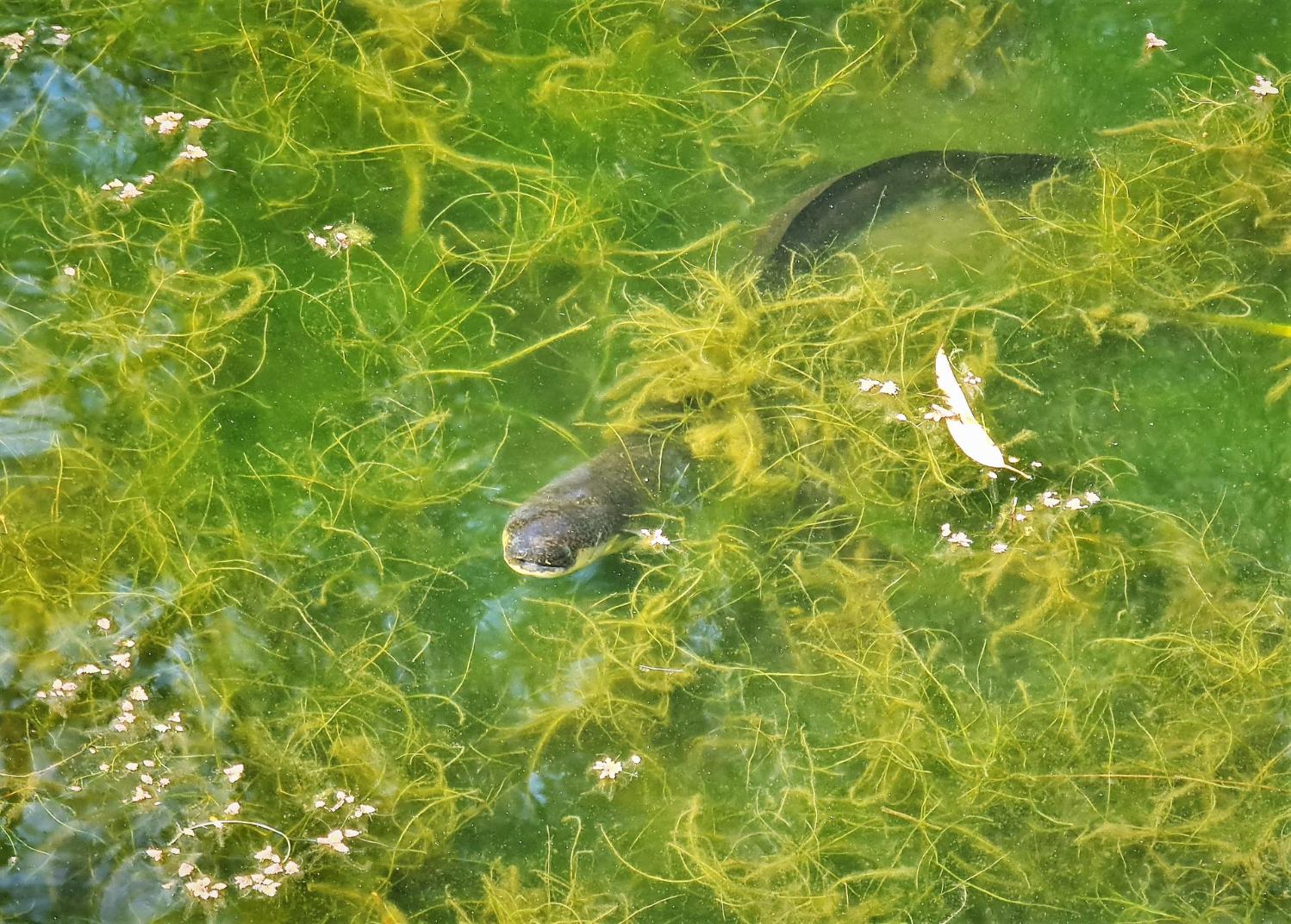
Time Of Burran
Gadalung Marool (hot and dry) January - March
The behaviour of the male kangaroos becomes quite aggressive in this season, and it is a sign that the eating of meat is forbidden during this time. This is a health factor; because of the heat of the day meat does not keep, and the likelihood of food poisoning is apparent. The blooming of the Weetjellan (Acacia implexa) is an important sign that fires must not be lit unless they are well away from bushland and on sand only, and that there will be violent storms and heavy rain, so camping near creeks and rivers is not recommended.
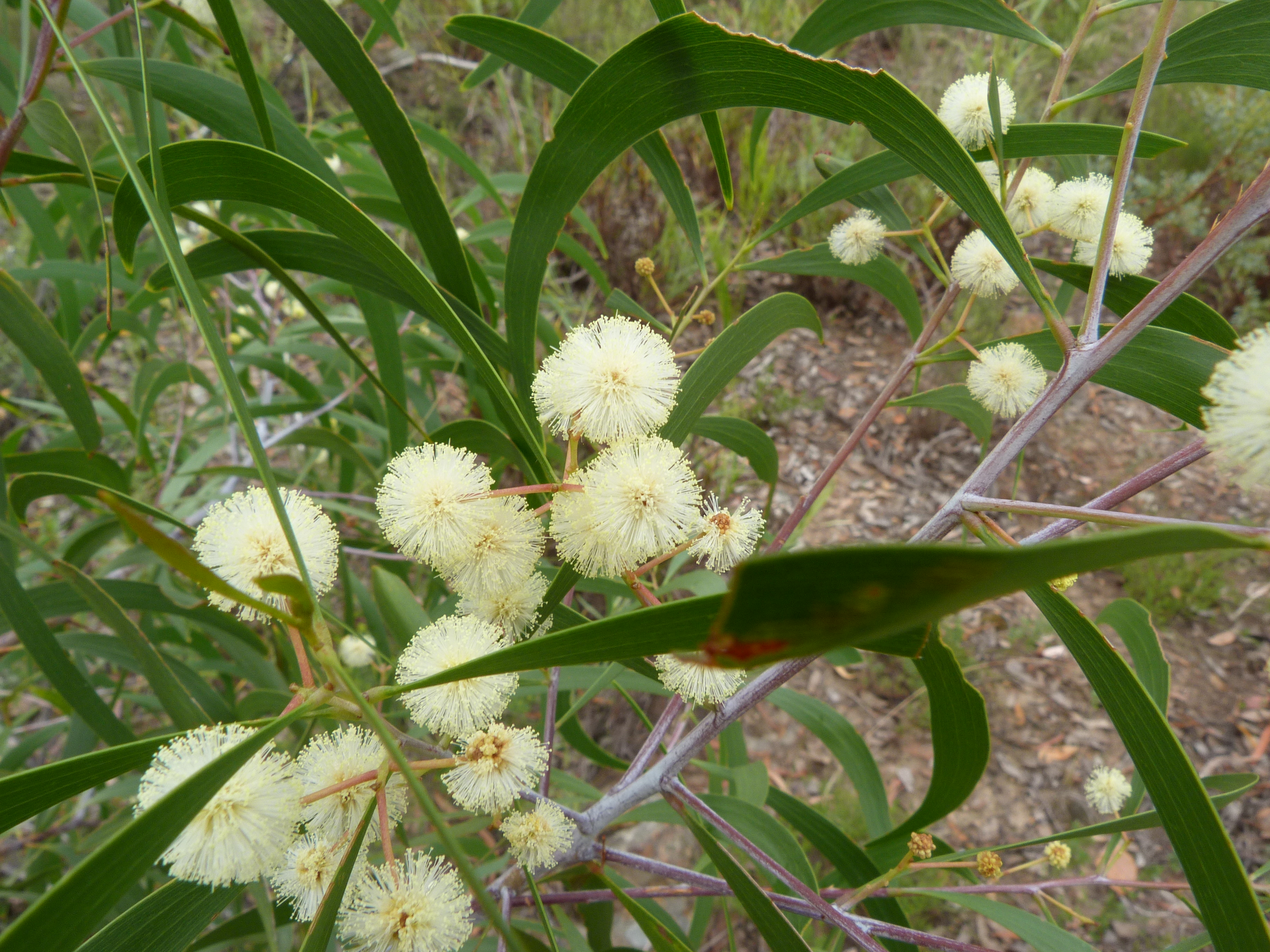
Acacia implexa, commonly known as lightwood or hickory wattle, is a fast-growing Australian tree, the timber of which was used for furniture making. The wood is prized for its finish and strength. The foliage was used to make pulp and dye cloth. The Ngunnawal people of the ACT used the bark to make rope, string, medicine and for fish poison, the timber for tools, and the seeds to make flour.
It is widespread in eastern Australia from central coastal Queensland to southern Victoria, with outlying populations on the Atherton Tableland in northern Queensland and Tasmania's King Island. The tree is commonly found on fertile plains and in hilly country it is usually part of open forest communities and grows in shallow drier sandy and clay soils.
Acacia implexa flowers - photo by Donald Hobern.
Spiders 'Ballooning' Come Ashore Across Our Beaches
Thousands of tiny spiders have been blown ashore from Manly to Palm Beach this week with residents stating that it was like being caught in a snow shower. Standing at oceans' edge on Monday December 7th, 2020, whether at Narrabeen or Bilgola, people thought a spider apocalypse, comprised of tiny spiders, had commenced.
Ballooning, also called 'kiting', is a process by which spiders, and some other small invertebrates, move through the air by releasing one or more gossamer threads to catch the wind, causing them to become airborne at the mercy of air currents and electric currents. A 2018 experiment confirmed that electric fields provide enough force to lift spiders in the air. This is primarily used by spiderlings to disperse; however, larger individuals have been observed doing so as well. The spider climbs to a high point and takes a stance with its abdomen to the sky, releasing fine silk threads from its spinneret until it becomes aloft. Journeys achieved vary from a few metres to hundreds of kilometres. Even atmospheric samples collected from balloons at five kilometres altitude and ships mid-ocean have reported spider landings. Mortality is high.
Research released in July 2020 from the University of Bristol sheds more light on “ballooning”, in which a spider holds on to a single strand of thread that carries them aloft. This feat was always assumed to be a matter of riding air currents by some unknown mechanism. Even Darwin was puzzled by “aeronaut spiders” reaching the Beagle on gossamer threads 60 miles off South America. Since 2013 researchers have believed electric fields are involved – now they have observed the effect experimentally.
The Bristol researchers showed that in a sealed chamber box with no air currents, spiders took off when an electric field was present, the repulsion on the charged thread providing the necessary lift. When the electric field was turned off, the spiders came back down.
Spiders have tiny hairs called trichobothria that sense electric fields, like human hairs rising in response to static electricity. When a spider senses the field is strong enough, they will climb to a high twig or blade of grass, spin a silken line, and take off.
Many sailors have reported spiders being caught in their ship's sails over 1,600 kilometres (990 mi) from land (Heimer 1988). They have even been detected in atmospheric data balloons collecting air samples at slightly less than 5 kilometres (16,000 ft) above sea level. Evidently, ballooning is the most common way for spiders to invade isolated islands and mountaintops. Spiderlings are known to survive without food while travelling in air currents of jet streams for 25 days or longer.
A close association has been found between ballooning behaviours and the ability for a species of spiders to survive afloat on water. Water-repellent legs keep them alive on both fresh and salt water, enabling them to survive waves up to 0.5 metres in height. In wind many species raised their legs or abdomens to use as sails, propelling themselves across the water's surface. Many species of spiders also drop silk to anchor themselves in place while afloat. Said spiders did not show these behaviours on land, suggesting that they are adaptations to water.
In June 2016 a flood in Tasmania caused spider ballooning there. A resident, Ken Puccetti, took photographs showing several trees shrouded in white webs, with small black spiders clearly visible on the silk folds.
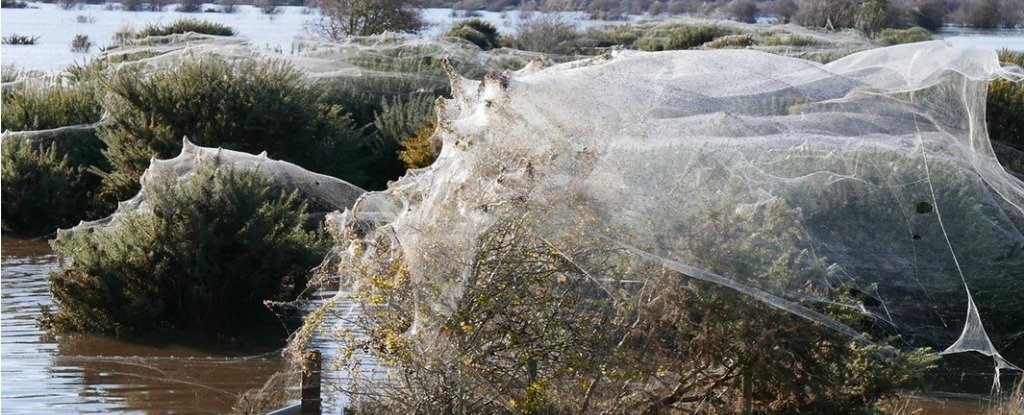
Spider webs cocoon bushes during the floods in Westbury, Tasmania in 2016. Photo credit: Ken Puccetti
Graham Milledge, the collection manager in arachnology at the Australian Museum, said the spiders were escaping the floodwaters using a phenomenon known as ballooning. This occurs when small spiders throw out silk filaments and catch a ride on the wind to higher ground.
A similar event occurred in Goulburn in the Southern Tablelands in May 2015, when a resident, Ian Watson, described how his house looked as if it had been "abandoned and taken over" by the spiders.
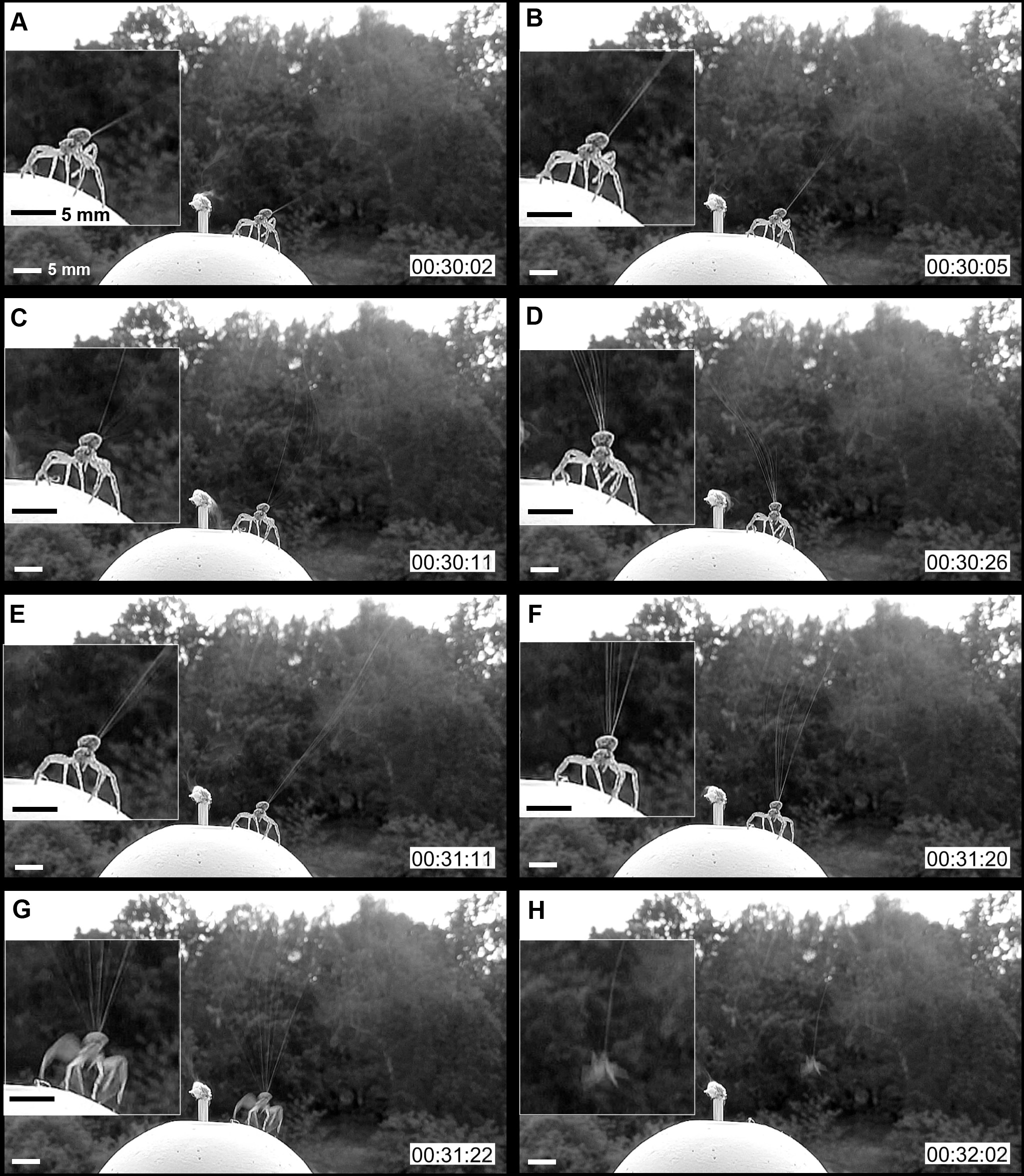
Cho M, Neubauer P, Fahrenson C, Rechenberg I (2018) An observational study of ballooning in large spiders: Nanoscale multifibers enable large spiders’ soaring flight. PLoS Biol 16(6): e2004405. https://doi.org/10.1371/journal.pbio.2004405 - File: Ballooning spider.png , http://journals.plos.org/plosbiology/article?id=10.1371/journal.pbio.2004405
Pittwater Natural Heritage Association (PNHA): Pittwater Nature Volume 3
Rescued Flying Foxes, Koolewong Track Trees, The Carrot Family, Appreciating Flies - and more in Pittwater Nature Issue 3 - available at:
http://pnha.org.au/whatsinside/uploads/2020/12/Issue-3-Pittwater-Nature.pdf
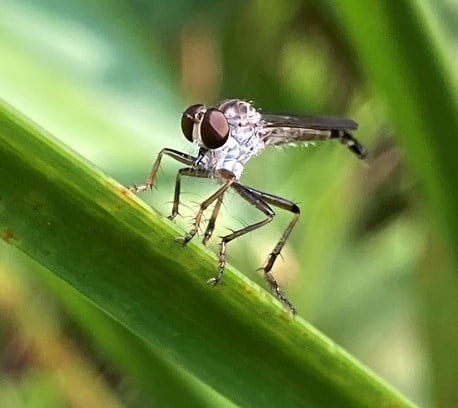
Along the Koolewong Track - mighty Sydney Red Gum Angophora costata. Photo by Marita Macrae - Robber Fly resting in Angophora Reserve Avalon. These flies hunt insects such as small moths. Photo by Marita Macrae.
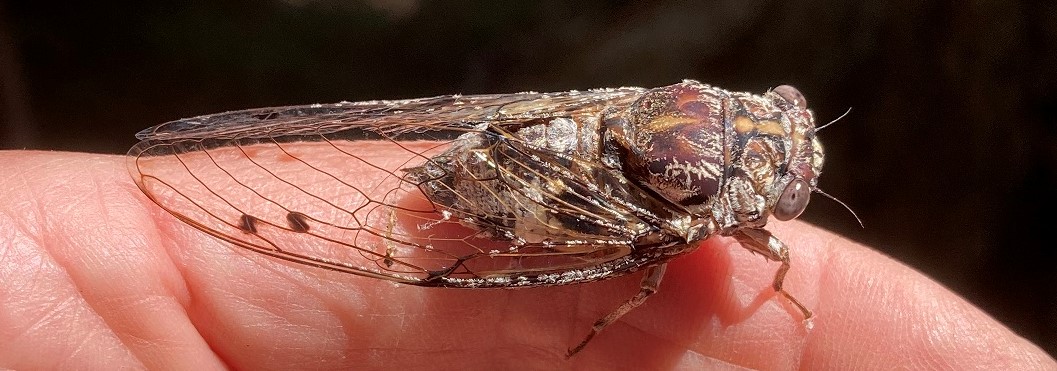
Floury Baker (Aleeta curvicosta), emerging in Avalon this week in early December. Photo by Marita Macrae.
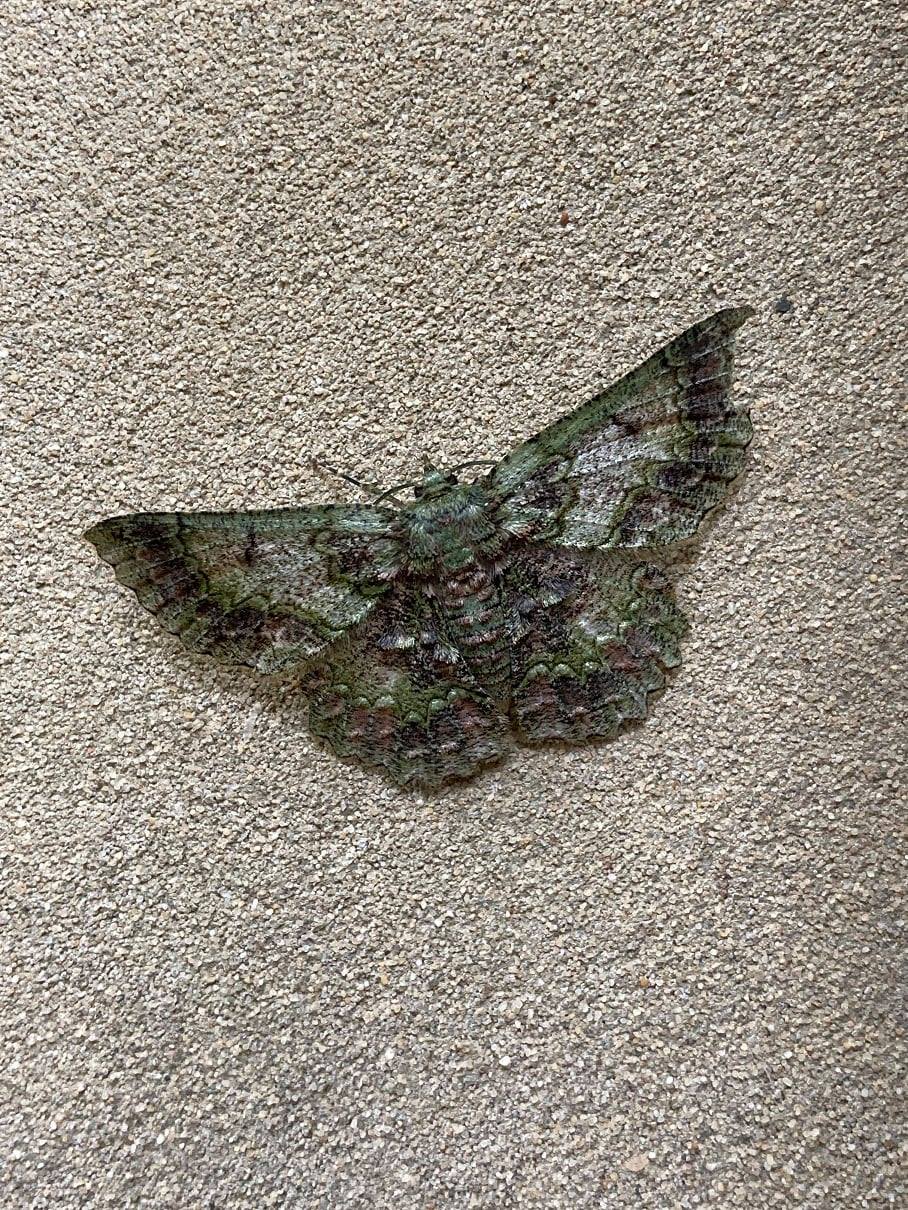
Textured Emerald Moth November 27 2020 - The lovely patterns and textures are formed by delicate scales. Moths can shed these easily to escape from a spider web. Photo by Marita Macrae.
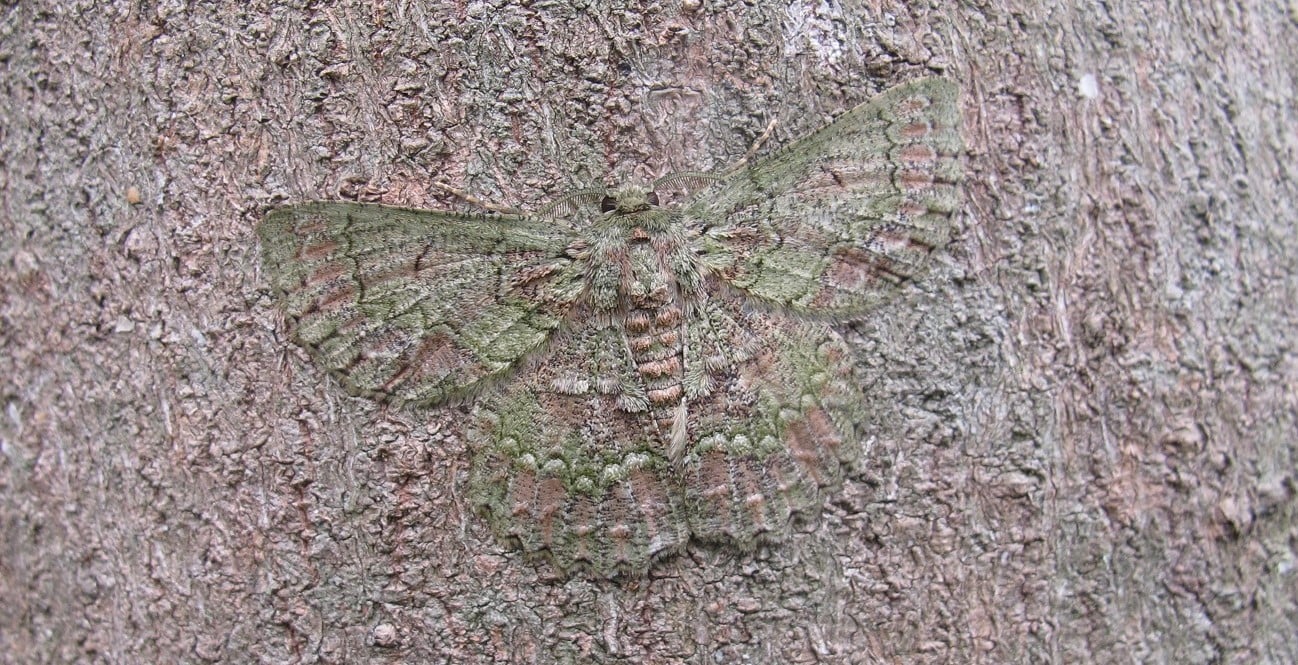
This one on bark of a Blueberry Ash. Imagine a fabric with these patterns! This photo taken October 7 2017. Photo by Marita Macrae.
Upcoming Activities For Friends Of Narrabeen Lagoon Catchment:
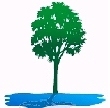 Sunday 27 December: 7.30 am Walk & Weed along 5 Mile Creek track in Garigal NP.
Sunday 27 December: 7.30 am Walk & Weed along 5 Mile Creek track in Garigal NP.
Short 15min walk to exotic grass and lantana infestation site. Weed for 2 hrs on rockshelf surrounded by beautiful bush.
Bring gloves and long handled screwdriver if available.
Walk easy-medium.
Finish 10.30am
Bookings essential. Conny 0432 643 295
Sun 21 February 2021: 7.30 am Walk & Weed along the Narrabeen Lagoon catchment transverse walk.
Start at Oxford Falls walk for 3 1/2 hours, weed for 30min, continue 30min walk and car pool back to start.
Bring gloves and long handled screwdriver if available.
Walk grade: medium.
Bookings essential. Conny 0432 643 295
https://www.narrabeenlagoon.org.au/
Friends of Narrabeen Lagoon Catchment are pleased to announce the next forum will be held on 22 Feb 2021 at 7 pm .
Presenter: Jayden Walsh
Jayden is a keen observer of nature and has some stunning photographs and information to share.
The focus will be on wildlife that lives near the Narrabeen Lagoon and that, if you are fortunate, you may see when on the Narrabeen Lagoon walkway.
For details on how to book for this event are on the website. At: https://www.narrabeenlagoon.org.au/Forums/forums.htm
Newport, Narrabeen Beach & Lagoon Clean Ups 2020 To 2021
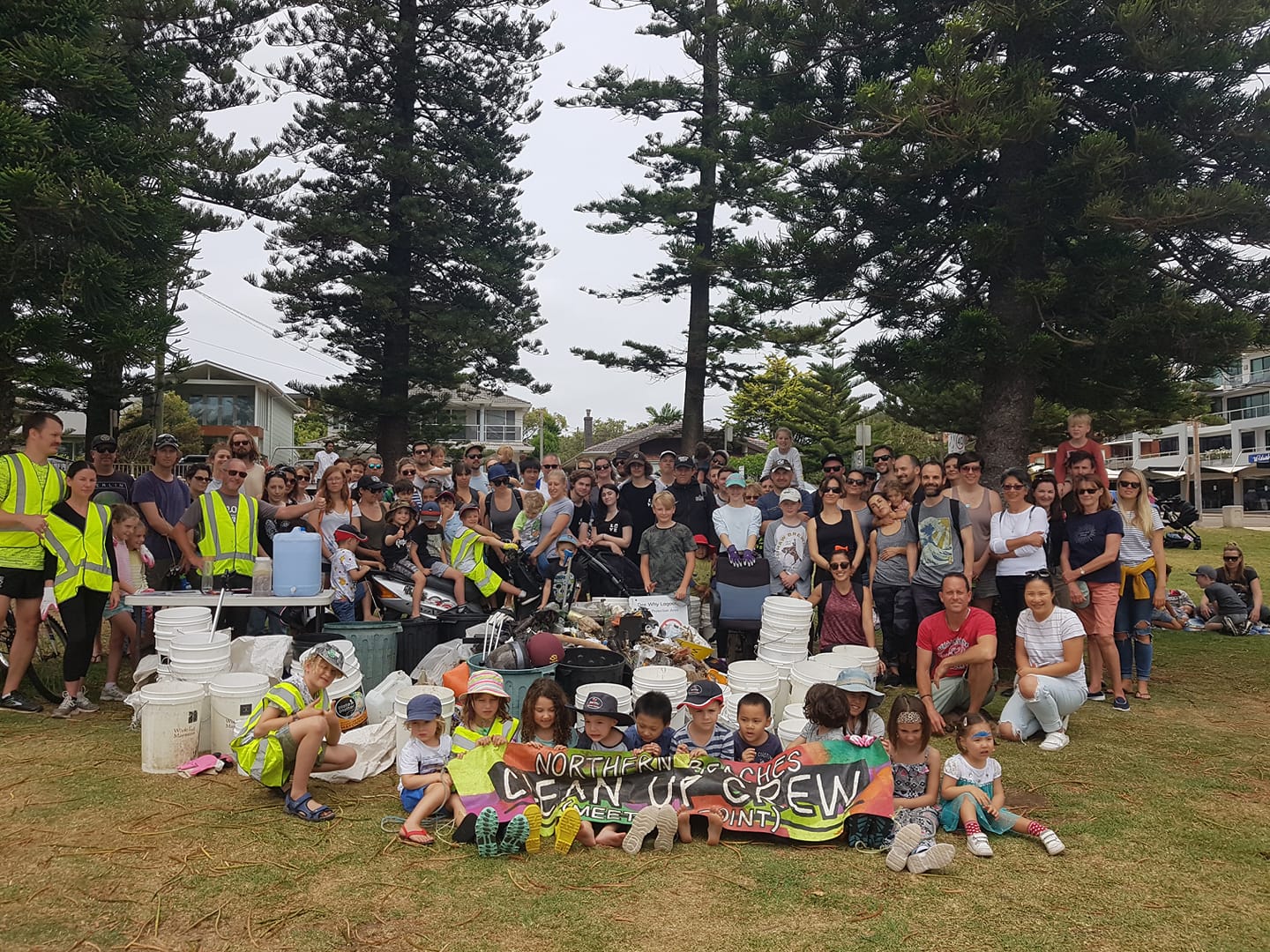
Living Ocean Expo Plus Tide & Moon Calendar Launch For 2021
Thursday, 17 December 2020 from 10:00 am
55 Old Barrenjoey Road, Avalon Beach
Living Ocean Expo will showcase our work and the work of our creative and passionate supporters on the ground floor shop 55 Old Barrenjoey Rd Avalon all day.
Drop-in and chat about our citizen science programs, have a tea or coffee with experts in environment and ocean science, and also see the works of our many supporters.
Rough schedule for guest experts who will be onsite during the day is;
10-11: Living Ocean Whales, plastic, seals, PEP11 software and more,
11-12: HSI talking sharks,
12-1: Surfers for Climate,
1-2pm: Cassie Murray all about whales,
2-3pm: Jools Farrell on ORRCA /NPWS rescue,
3-4pm: David Jenkins Whalespotter,
4-5pm: Matt Kemp on Ocean expeditions.
Then at 6.30 we will launch the Tide and Moon Calendar 2020.
We feature 12 images from our talented supporters who donated to the calendar Their works will be on display all day. Chat with each and listen to how they capture their visions of the ocean.
Photographers include: Rita Kluge, Robbi Newman, Jack McCoy, David Jenkins, Guy Williment, Tim Bonython, Guy Finlay, Tom Carroll, Jake Parker, Steve Maxwell, Claudia Newman, Matt Kemp.
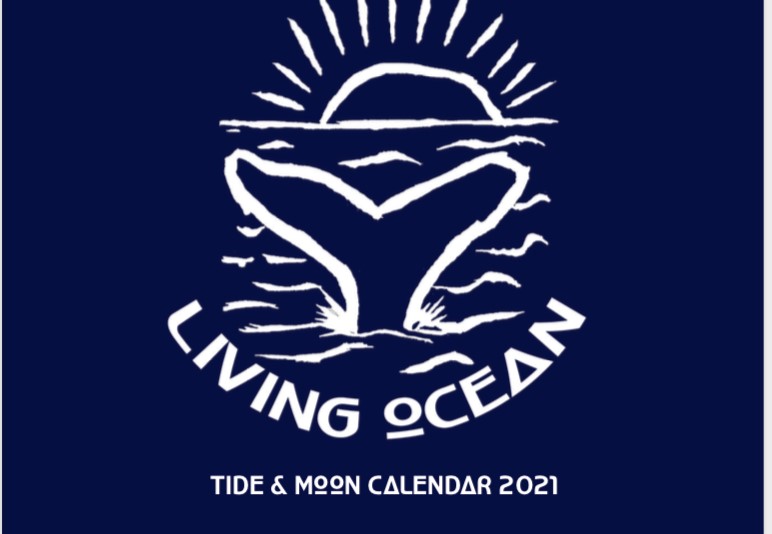
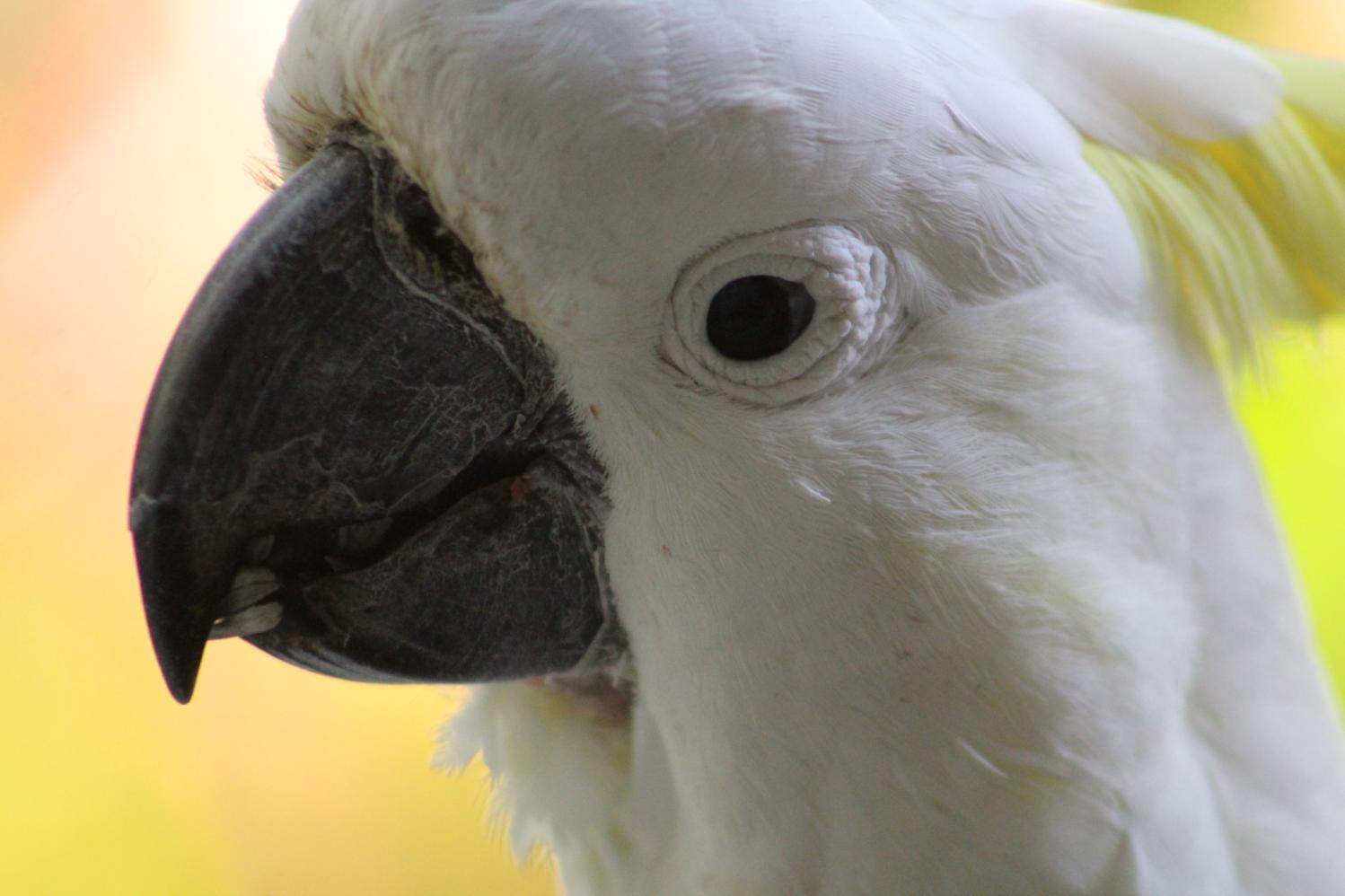
Watch Out On The Pittwater Estuary Water Zones & Beaches: Seals & Penguins Are About
Residents have filmed and photographed the seals living at Barrenjoey as far south as Rowland Reserve and over at Clareville beach in recent days and ask that people keep an eye out for them and ensure they are kept safe from boat strikes and dogs are kept off the beaches they're not supposed to be on.
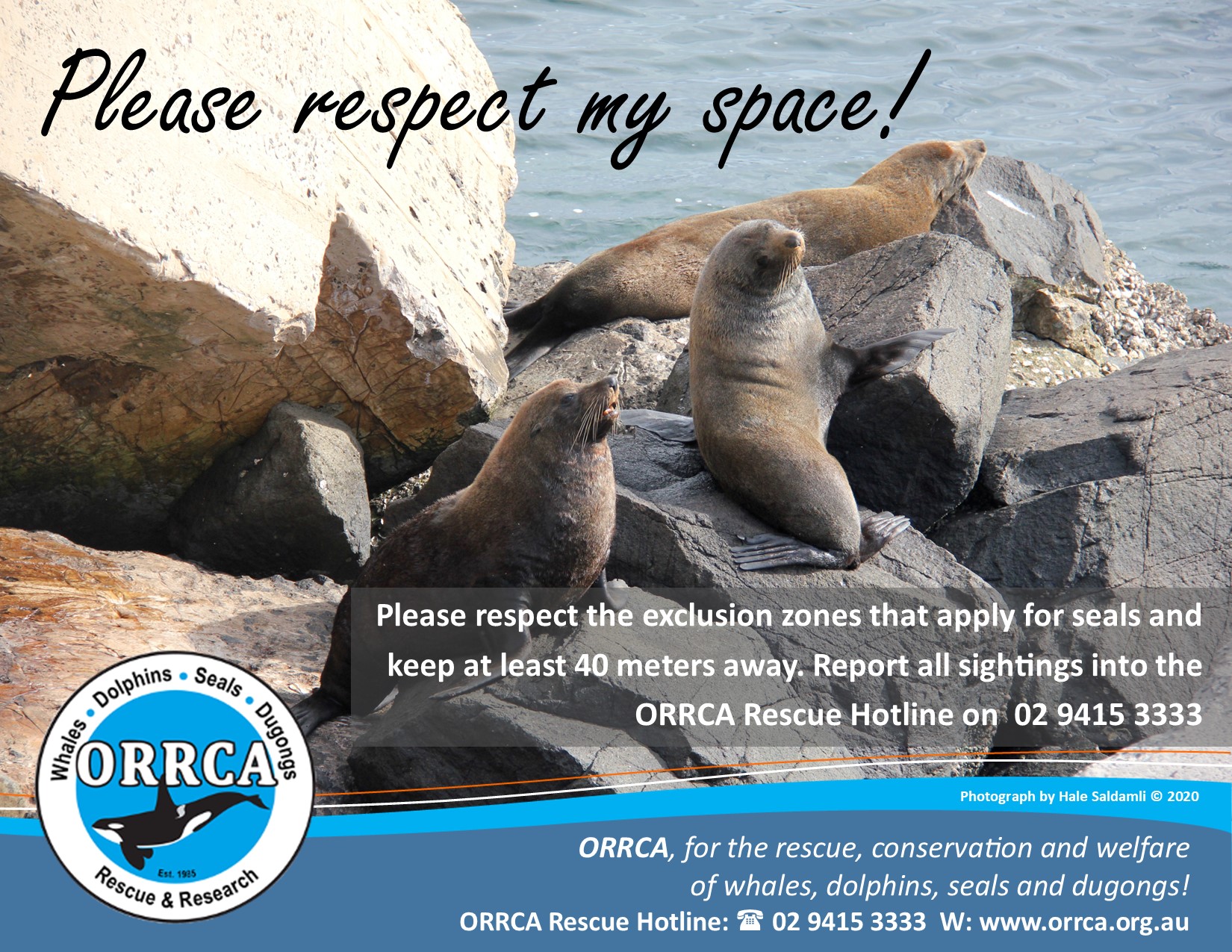
Bushcare In Pittwater
Where we work Which day What time
Avalon
Angophora Reserve 3rd Sunday 8:30 - 11:30am
Avalon Dunes 1st Sunday 8:30 - 11:30am
Avalon Golf Course 2nd Wednesday 3 - 5:30pm
Careel Creek 4th Saturday 8:30 - 11:30am
Toongari Reserve 3rd Saturday 9 - 12noon (8 - 11am in summer)
Bangalley Headland 2nd Sunday 9 to 12noon
Bayview
Winnererremy Bay 4th Sunday 9 to 12noon
Bilgola
North Bilgola Beach 3rd Monday 9 - 12noon
Algona Reserve 1st Saturday 9 - 12noon
Plateau Park 1st Friday 8:30 - 11:30am
Church Point
Browns Bay Reserve 1st Tuesday 9 - 12noon
McCarrs Creek Reserve Contact Bushcare Officer To be confirmed
Clareville
Old Wharf Reserve 3rd Saturday 8 - 11am
Elanora
Kundibah Reserve 4th Sunday 8:30 - 11:30am
 Mona Vale
Mona Vale Mona Vale Beach Basin 1st Saturday 8 - 11am
Mona Vale Dunes 2nd Saturday +3rd Thursday 8:30 - 11:30am
Newport
Bungan Beach 4th Sunday 9 - 12noon
Crescent Reserve 3rd Sunday 9 - 12noon
North Newport Beach 4th Saturday 8:30 - 11:30am
Porter Reserve 2nd Saturday 8 - 11am
North Narrabeen
Irrawong Reserve 2nd Saturday 2 - 5pm
Palm Beach
North Palm Beach Dunes 3rd Saturday 9 - 12noon
Scotland Island
Catherine Park 2nd Sunday 10 - 12:30pm
Elizabeth Park 1st Saturday 9 - 12noon
Pathilda Reserve 3rd Saturday 9 - 12noon
Warriewood
Warriewood Wetlands 1st Sunday 8:30 - 11:30am
Whale Beach
Norma Park 1st Friday 9 - 12noon
Western Foreshores
Coopers Point, Elvina Bay 2nd Sunday 10 - 1pm
Rocky Point, Elvina Bay 1st Monday 9 - 12noon
Gardens And Environment Groups And Organisations In Pittwater
Grants To Fund Innovative Re-Use And Recycling Projects
The NSW Environment Protection Authority (EPA) is calling for innovative and new projects looking for ways to re-use discarded materials to make new products or for new uses, and for construction projects that want to re-use materials like construction waste, glass or plastic, to apply for new grants to help create a circular economy.
New intakes for the EPA’s Circulate and Civil Construction Market Programs are now open and aiming to divert valuable materials from landfill for re-use, recycling and industrial ecology projects.
The grant funding helps organisations including businesses, councils, not-for-profits, waste service providers and industry bodies, among others, design projects that promote the circular economy, instead of a disposable culture.
EPA Director Circular Economy Programs Kathy Giunta said these programs will provide grant funding to support industry to respond to the decision by the Council of Australian Governments (COAG) this year to ban the export of certain wastes that have not been processed into value-added material.
“One of the ways to mitigate the effects of China’s National Sword policy and to prepare NSW for the waste export ban is to invest in projects that demonstrate innovative uses of recyclables,” Ms Giunta said.
“The Circulate Program provides grants of up to $150,000 for innovative, commercially-oriented industrial ecology projects. Circulate supports projects that will recover materials that would otherwise be sent to landfill, and to instead use them as feedstock for other commercial, industrial or construction processes.
“The Civil Construction Market Program provides grants of up to $250,000 for civil construction projects that re-use construction and demolition waste or recyclables from households and businesses such as glass, plastic and paper.”
Previous projects in the Circulate Program include Cross Connections’ Plastic Police, which supplied soft plastics to the Downer Group’s Reconophalt project, the first road surfacing material in Australia to contain high recycled content from waste streams, also including glass and toner, which would otherwise be bound for landfill or stockpiled.
Previous projects in the Civil Construction Market Program include supporting Lendlease’s use of recycled glass from Lismore Council in pavement concrete on three trial sites as part of the Woolgoolga to Ballina Pacific Highway Upgrade.
Applications will be open until Friday 12 February 2021.
For details of the grants and how to apply, visit epa.nsw.gov.au/circulate and epa.nsw.gov.au/working-together/grants/business-recycling/civil-construction-market-program-grants
Music Could Be Key In Finding Rare NSW Bird Species
December 2020
In the middle of NSW there's a cryptic bird so elusive that the NSW Government's Saving our Species program has turned to music to detect it.
Threatened species experts have been recording birdsongs – through bioacoustic technology – to monitor and track the critically endangered red-lored whistler (Pachycephala rufogularis) in the Central West's Round Hill and Nombinnie Nature Reserves.
This novel technique holds promise for monitoring rare birds across the State, according to Sarah Bell, Senior Project Officer Saving our Species.
"With a cryptic bird like the red-lored whistler, your chance of seeing one is pretty low, but detecting their noise lets us know if there are any out there," Dr Bell said.
"These birdsong recordings will help us understand their movements and hopefully lead to better conservation outcomes.
"Hearing the red-lored whistler call really is the best music to our ears as it gives us hope that we might be able to help save this bird.
"We are starting from a point of having no firm idea what the population trend of this bird is, whether it's going up or down or staying the same, or what habitat they prefer.
"For the past 2 years our team has left small recording devices in the reserves, for a few months at a time, to capture bird songs and calls from the surrounding landscape," Dr Bell said.
"We take the song files back to the office to analyse them – we can separate the red-lored whistler from other bird calls – even from the very similar-sounding Gilbert's whistler, for which it's often mistaken."
The team will record bird songs over a 6-year period, which is the generational life-span of the red-lored whistler. During this time, recordings will be made from 155 locations.
Once many months of sound-data files are downloaded, they are run through a software program which assists in the identification of various bird calls. The data will be used to investigate the red-lored whistlers' occupancy across the reserve and changes over time to indicate the population trajectory.
The red-lored whistler is a 'shy' small, grey-brown songbird with attractive orange-red trimming on its lore, which is the area on the side of a bird's face between its eye and bill.
Red-lored whistlers blend easily into their surrounds and are rarely seen flying around the Mallee woodland in which they live. As far as the team knows, this is the only population remaining in New South Wales.
Red Lored Whistler (Pachycephala Rufogularis )HD Video Clip 1/1 By Tim Siggs ABVC
Even though the footage is a little wobbly, I have included this in the collection as it is a bird of very limited distribution. They have an evocative call which carries some distance through the Mallee country. I had seen this species 20 years ago but was surprised how 'chunky' they were. They are also quite terrestrial as is shown in the video. Tim Siggs.ABVC. This bird Video is part of my channel started in 2015. My ambition is to showcase 500 Australian bird species. I am passionate about Bird Video as it Potentially shows bird behaviour, breeding and often bird song.
I began birdwatching when I was 12 and progressed to bird photography and then to bird Video for the past 15 years.
Originally from the UK, I find birding in Australia exciting and engaging. I have now travelled around Australia twice but mainly film birds in Queensland.
Many of the bird clips are taken from hides or blinds that I construct from bush materials, saving the need to carry a hide to a location.
Knowing bird calls and song is a big part of finding each species and naturally, knowing the habitat requirements helps also.
Enjoy.
Volunteers Helping To Protect Endangered Little Terns Nesting On Corrie Island
December 2020
NSW National Parks and Wildlife Service (NPWS) and volunteers from the Myall Koala & Environmental Group are working together to protect a nesting colony of endangered little terns on Corrie Island Nature Reserve, as part of the NSW Government's Saving our Species Program.
NSW Government Saving our Species Officer Christophe Tourenq said it was fantastic to see that little terns have returned to the island in the Lower Myall River mouth to breed this year.
"We're relieved to see that this colony of little terns has returned to Corrie Island to breed for the 61st year running," said Mr Tourenq.
"Little terns have been recorded breeding on and off the island and the nearby beach of Winda Woppa since the 1950's and probably much earlier.
"Volunteers from Myall Koala & Environmental Group have counted 60 nests so far this season, which is already the double of the number reached last year at the peak of the breeding season.
"Little terns are endangered in NSW and sadly their populations are in decline. The big issue for little terns is that they breed during summer on beaches and sand spits – the same spaces where humans like to sit, camp and walk their unleashed dogs during the warm weather.
"Their eggs and chicks are so well camouflaged against the sand; they are almost invisible and all too easy for people and their pets to disturb, or even crush, without noticing. Luckily, Corrie Island is relatively isolated, so we hope they will have a better shot at a successful breeding season in 2020–21.
"We're asking members of the public to please 'share the shore', respect the signs, and to refrain from visiting the island during the breeding season, which runs from November to February. Eggs or chicks could be anywhere on the island above the high tide line.
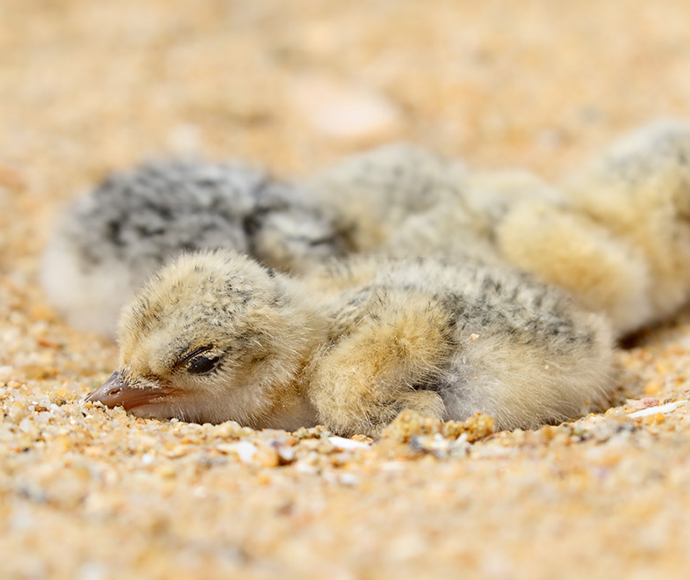
Little tern chicks (Sternula albifrons) Credit: Leo Berzins
Volunteers have been essential in helping NPWS to gather data on shorebirds in the Port Stephens estuary. Since 2004, the Hunter Bird Observers Club have conducted summer surveys, and for the last four seasons, a small group of volunteers from the Myall Koala & Environmental Group have been monitoring and protect the nesting birds on Corrie Island.
Myall Koala & Environmental Group's Trish Blair said "It is a pleasure and a privilege for us to play a part in helping to collect data about the numbers and breeding success of endangered shorebird species, and to take any action, in conjunction with relevant Government agencies to reduce the risk of destruction of eggs and chicks."
"Our usual mode of transport to the nesting site is by kayak and on foot in our beautiful natural coastal environment. So, our 'work' is not onerous at all," said Ms Blair.
People are reminded that camping and domestic pets are not allowed into Corrie Island Nature Reserve at any time.
For more information about little terns, visit the Department of Planning, Industry and Environment website.
Ongoing Education And Enforcement Of Sediment Controls On Building Sites Key To Protecting Sydney's Waterways
December 2020
Results from the October Get the Site Right inspection blitz day show that compliance rates on construction and building sites are holding steady following the significant improvements seen in the June campaign.
The results are encouraging in light of the recent rainfall surge experienced across Sydney and parts of eastern Australia and increase in building and renovation projects since the start of COVID-19.
Twenty-one councils across Sydney and the Hunter Coast and the NSW Environment Protection Authority took part in the one-day blitz with officers inspecting almost 600 building and construction sites for sediment and runoff controls.
Of the sites inspected, 74 per cent were compliant, up 1 per cent from the June campaign. A total of $97,897 in fines was issued to non-compliant sites. Offences ranged from poorly stabilised site access, unapproved concrete pours and the inappropriate storage of building materials.
Get the Site Right targets erosion and sediment control on building and construction sites and highlights the impact of sediment-laden runoff on our waterways. It is a joint program between the Parramatta River Catchment Group, Cooks River Alliance, Georges River Combined Councils Committee, Sydney Coastal Councils Group, Lake Macquarie Council, NSW Environment Protection Authority (EPA), Department of Planning, Industry and Environment (DPIE), and local councils.
EPA Executive Director Regulatory Operations, Steve Beaman, said the consistent compliance rate was reassuring, given the continuing wet weather forecast for coming months.
“Building materials such as sand and soil that are not properly contained can be blown or washed off a site into stormwater drains and out to our local waterways,” Mr Beaman said.
“Sediment runoff can harm aquatic life, erode creeks and riverbanks and damage stormwater infrastructure.
“During this period of wet weather, it’s even more important that builders and developers use the right erosion and sediment controls to prevent runoff leaving their site.”
Parramatta River Catchment Group (PRCG) Chair, Councillor Mark Drury, said the positive results highlight the importance of the Get the Site Right campaign in encouraging and supporting councils to conduct regular inspections and educate developers and builders on the role they play in protecting our waterways.
“With an increase in construction expected over the next 12 months due to the government stimulus packages for builders and renovators, raising awareness of the harmful impact of sediment runoff on our rivers and creeks is still needed,” Cr Drury said.
“Get the Site Right continues to demonstrate how catchment groups, councils and the EPA are working together to achieve sustainable benefits for the community and environment.”
Members of the public are encouraged to report pollution incidents, including poor sediment control, to their local council or the EPA’s 24/7 Environment Line on 131 555.
Global Search Lands New Chief Executive For Placemaking NSW
December 2020
Anita Mitchell has been named Chief Executive, Placemaking NSW, to lead the team responsible for managing and transforming some of NSW’s most treasured places including The Rocks and Darling Harbour, Sydney Olympic Park, and in the Hunter and Central Coast.

Announcing the appointment, NSW Department of Planning, Industry and Environment Secretary Jim Betts said Ms Mitchell was a leader with outstanding international property, risk, and place credentials earned in Australia, Asia, and in Europe.
“Our priceless state assets need a strong leader with a place focus to drive renewal, investment and growth, while protecting and enhancing natural and cultural heritage,” Mr Betts said.
“This was an exhaustive and highly competitive global search. I’m delighted we’ve been able to secure Anita’s capability and experience with global property and investment group Lendlease in Europe, Asia and in Sydney, as well as other property firms such as Jones Lang Lasalle,” he said.
Anita Mitchell said she was thrilled to join the Department’s Place, Design and Public Spaces team as Chief Executive, Placemaking NSW.
“This is a once in a lifetime opportunity. I see many ways to continue to take placemaking beyond managing just the physical spaces to something that delivers great experiences and real social, economic and environmental value for the community,” Ms Mitchell said.
“I’m looking forward to leading a passionate team in realising the full potential of some of New South Wales’ most treasured places and public spaces.”
Anita Mitchell will commence in the role of Chief Executive, Placemaking NSW on 18 January 2021.
Enhancements To Boost BASIX System Released
December 2020
The transformation of BASIX is underway, with a number of significant changes implemented to provide greater flexibility and enable more innovative and sustainable design solutions.
The Building Sustainability Index (BASIX) is an online sustainability assessment tool that ensures proposed residential development meets sustainability targets and is one of the main drivers of energy and water efficiency for housing in NSW .
Minister for Planning and Public Spaces Rob Stokes said updates to the online BASIX tool would incorporate innovations in more sustainable technologies and align it with sustainability targets in other states.
“There have been tremendous technological advances within the sustainability sector since the introduction of BASIX and we’re updating the platform to make it more flexible, innovative and easier to use,” Mr Stokes said.
“BASIX standards should be the baseline, not the boundary. These updates will allow architects to exceed the standards, achieve great design and ensure homes are energy efficient.”
“Since its introduction in 2004, more than 460,000 homes have been certified as BASIX compliant, saving an estimated 281 billion litres of drinking water and 8.8 million tons of emissions.”
Some of the main changes include:
- Recognising other sustainable building design standards, such as Passive House, to meet BASIX thermal comfort requirements;
- Updating the online tool to include new technology choices such as regenerative drive technology for lifts;
- Aligning the BASIX thermal comfort modelling requirements with the national standard under NatHERS.
Australian Passive House Association CEO Paul Wall welcomed the platform being recognised in BASIX assessments.
“The thermal comfort assessment we provide results in a win-win. Homeowners and tenants get a more comfortable home with reduced running costs, while the environmental impact is significantly reduced,” Mr Wall said.
For more information visit the BASIX website.
60,000 Murray Cod Released Back Into The Darling River
December 2020
A bold rescue-and-return mission by the NSW Government has successfully seen more than 60,000 Murray Cod released back into the Darling River near Menindee today, December 7, 2020, two years after severe drought triggered fish deaths.
Premier Gladys Berejiklian joined Minister for Agriculture and Minister for Western NSW Adam Marshall at Menindee to oversee the restocking of the Darling River.
Ms Berejiklian said the return of the Murray Cod to the waterway was part of the NSW Government’s ambitious plan to help restock the Darling River.
“This is a historic day for the Menindee community and the Barkindji people in particular,” Ms Berejiklian said.
“Two years ago widespread fish deaths were caused by high temperatures and record low rainfall so it gives me great joy to see these Murray Cod returned home and swimming through our healthy waterways.”
Mr Marshall said the fish were offspring of 70 Murray Cod rescued after the NSW Government last year took unprecedented action to launch the State’s largest-ever breeding program.
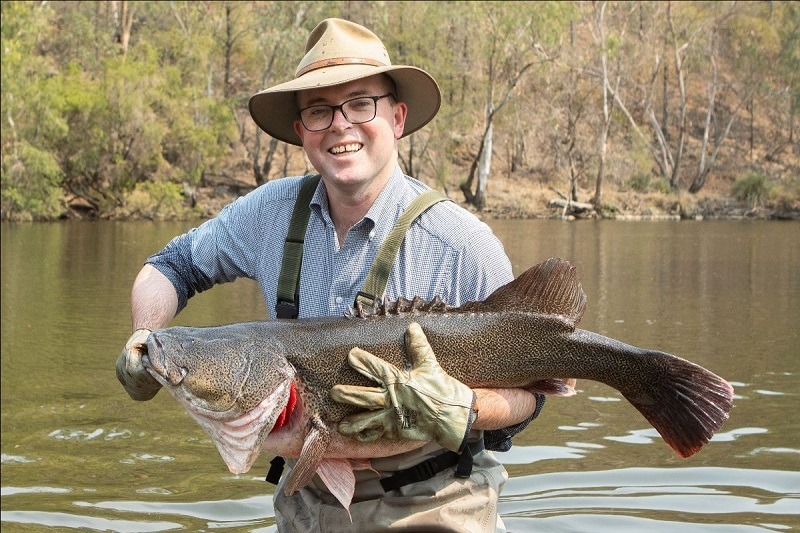
Minister Marshall
“Fast-forward to today and our virtual ‘Noah’s Ark’ has docked home, returning a massive 60,000 Murray Cod to their native river, a major milestone in the NSW Government’s $10 million Fish Rescue Strategy,” Mr Marshall said.
“The iconic Murray Cod is particularly special to both the Menindee region and local indigenous communities, so to stand here today with key community members and First Nations representatives as these fish are returned to country is very moving.
“This is just the start of something special. These 60,000 Murray Cod are only the first of more than 400,000 fish to be stocked across the State this month alone, and we will continue breeding 2.5 million native fish species each year to keep our rivers stocked.”
Mr Marshall said the Murray Cod restocked today were the offspring of fish rescued by NSW Department of Primary Industries (DPI) Fisheries from Menindee in the sweltering summer of 2019, and more saved the following summer.
“The rescued Murray Cod were taken to the NSW Government’s flagship fish hatchery at Narrandera, where they stayed until conditions improved,” Mr Marshall said.
“DPI has done a phenomenal job in breeding these offspring. This program ensures the survival of our fish species, no matter how severe future summers might be.”
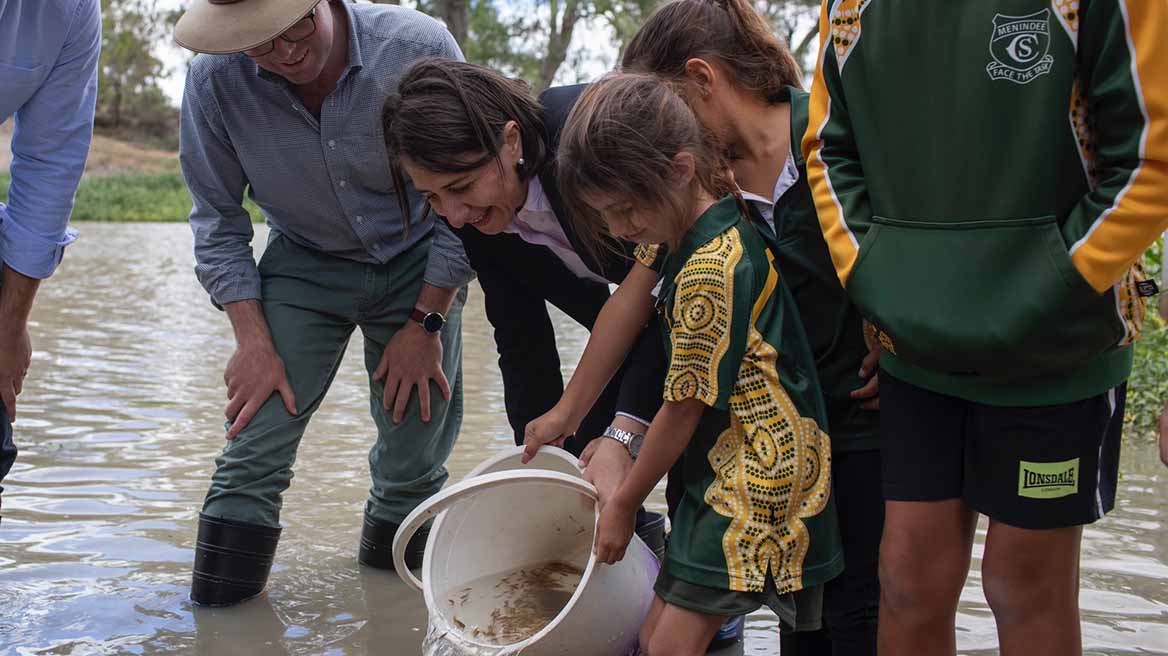
Ongoing Operations To Remove Feral Deer In Royal National Park A Success
December 2020
The National Parks and Wildlife Service (NPWS) continues pest management operations across fire-impacted bushland with a recent operation removing rusa deer from Sydney's Royal National Park.
NPWS Area Manager Brendon Neilly said feral deer management is expanding into more remote, harder to access areas of Royal National Park using a range of effective and humane methods.
"Controlling feral deer in the park is a critical priority for NPWS," said Mr Neilly.
"Deer cause damage to native habitats through grazing, browsing, trampling and wallowing.
"Last month's operation saw highly trained, skilled staff remove deer from a 2000-hectare section of the park that was burnt by wildfire in 2018.
"Deer are impacting native plants and native habitats recovering from fire in this part of the park, including the Littoral Rainforest Threatened Ecological Community.
"The area has limited trails and is not suitable for effective ground shooting so an aerial operation was conducted in accordance with the highest safety and animals welfare standards.
"The half-day operation using thermal imaging technology removed 58 rusa deer in order to protect the area's conservation values.
"Independent expert advice is that aerial control is a humane method by for managing invasive pest animals and the operation was controlled by strict operational procedures that prioritised staff and visitor safety.
"NPWS has undertaken regular deer control in Royal National Park since 2002 and will continue to utilise both ground and aerial control methods to reduce the impact of feral deer on the environment and the community," Mr Neilly said.
Feral deer populations continue to expand across different land tenures and now occupy an area covering around 22 per cent of NSW, up five per cent from 2016.
They pose a significant threat to the survival and recovery of native vegetation, especially after fire.
Following last summer's bushfires, NPWS is implementing the largest feral animal control operation in its history to give native plants and animals the best chance to recover.
Toxic Strangler Weed Found In Bourke And Brewarrina Shires
December 2020
Property owners and land managers in north west NSW have been urged to check their properties for the toxic invasive weed, rubber vine (Cryptostegia grandiflora), which is now being eradicated from four sites near Wanaaring, Yantabulla and Weilmoringle.
NSW Department of Primary Industries (DPI) State Priority Weeds coordinator, Nicola Dixon, said people in the Bourke and Brewarrina Shire Council and unincorporated areas should check homestead gardens, yards, sheds, rivers and creeks for the prohibited weed.
“We have found rubber vine which was planted in homestead gardens decades ago, triggering a substantial surveillance effort as plants could survive anywhere there is a water source and could have spread far from the original sites,” Ms Dixon said.
“Please contact the NSW DPI Biosecurity Helpline on 1800 680 244 for assistance and do not attempt to treat or dispose of this weed yourself.”
NSW DPI is working with Western Local Land Services and local councils to detect and eradicate rubber vine.
As part of an ongoing 46,000 square kilometre survey of north-west NSW, between Tibooburra and the Narran River, 191 properties have been inspected for rubber vine.
Rubber vine is a multi-stemmed shrub which can scramble up to 30 metres high in tree canopies or grow unsupported to three metres, forming dense thickets with dark green, glossy leaves. Its flowers are trumpet-shaped, up to five centimetres long and wide with five light-purple, pink or white petals.
The weed smothers and kills other plants, invades pastures, waterways and natural areas and makes livestock movement and mustering difficult. It can reduce native plant and animal numbers and the water quality of streams.
All parts of the plant are poisonous to people and livestock if eaten. Sap from the plant irritates skin and can cause burning, rashes and blisters. Dust from dried plants can cause irritation to the throat, nose and eyes.
Rubber vine is a Weed of National Significance which poses a significant biosecurity risk and is listed as prohibited matter in the NSW Biosecurity Act 2015.
Information about rubber weed is available from the DPI website.
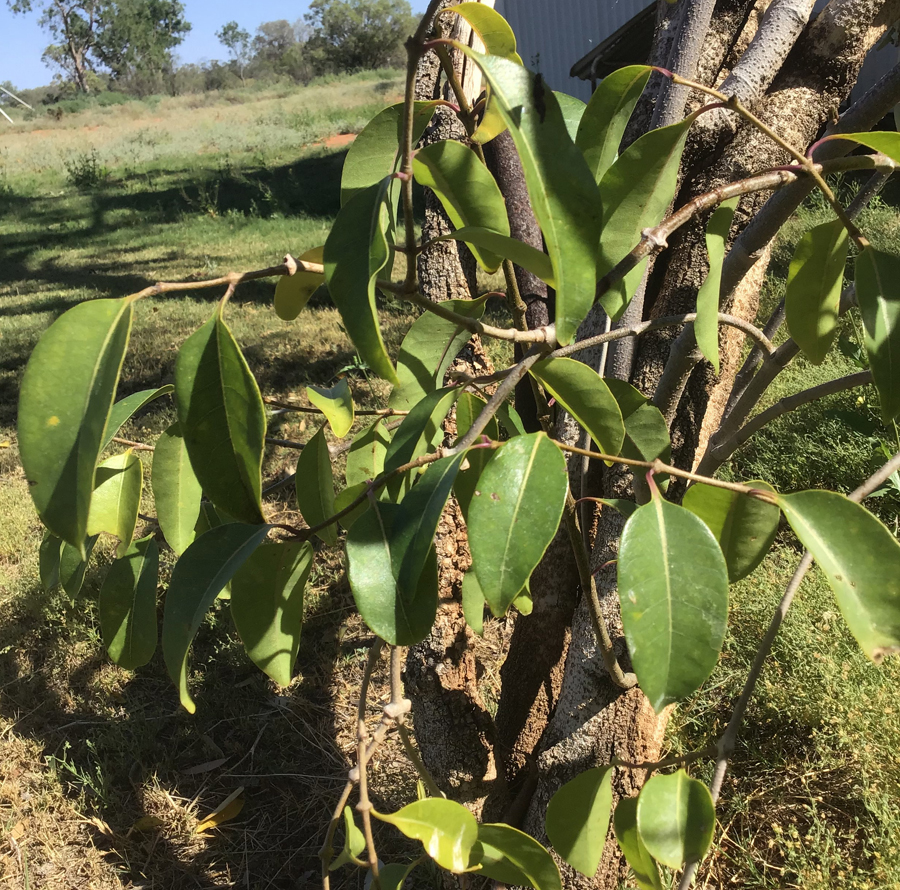
Look out for rubber vine in north-west NSW and contact NSW DPI Biosecurity Helpline on 1800 680 244 for assistance, do not attempt to treat or dispose of this weed yourself. All parts of the plant are poisonous to people and livestock if eaten. Sap from the plant irritates skin and can cause burning, rashes and blisters. Dust from dried plants can cause irritation to the throat, nose and eyes.
Judges House Opens At Yellow Rock
December 2020
A newly refurbished cottage located between the bush and the beach in Murramarang National Park has now opened for guests, providing unique visitor accommodation in one of the most pristine locations on the sought-after NSW south coast.
Located in Yellow Rock, Murramarang National Park, the Judges House is nestled in bushland with access to a secluded beach and boasts stunning views across Batemans Bay.
The three-bedroom weatherboard cottage features huge windows which bring the outside in, an open plan living area and large wraparound deck to relax on and enjoy the natural surrounds and water views.
Judges House is perfect for families, couples, small groups, from Sydney, Canberra and other areas of NSW wanting to enjoy a quiet getaway with many activities on offer, while for bigger groups the existing Yellow Rock Beach House nearby is also available to be booked.
The new accommodation offers access to its own private beach just steps away for swimming, kayaking or canoeing and fishing. Guests can explore bushwalking tracks in the area which wind through coastal bushland and the rocky coves of Murramarang National Park.
Ideal for holidaymakers wanting a remote nature stay with modern conveniences within reach, Judges House is only a 30-minute drive from the restaurants, cafes and shops of vibrant coastal town Batemans Bay.
Over the past year NPWS has carried out structural and engineering works, services upgrades, complete internal refurbishment, an extension to the deck and newly appointed fittings and furnishings throughout.
Revenue from the accommodation will be re-invested in the maintenance of the cottage and the Murramarang National Park.
Rates: From $350 – $450 per night. Minimum stay requirement applies.
For more information or to book call 1300 072 757 (13000 PARKS) or visit Judges House
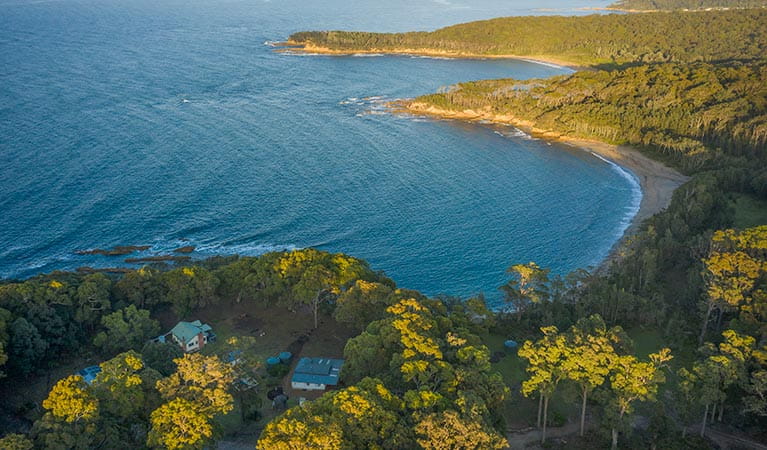
The Blue Mountains World Heritage site has been downgraded, but it's not too late to save it
Ian Wright, Western Sydney University; Anthony Capon, Monash University, and Leo Robba, Western Sydney UniversityTwenty years ago, UNESCO inscribed the greater Blue Mountains area on the World Heritage List for having “outstanding universal value”.
If you’ve travelled to the Blue Mountains, with its rugged sandstone cliff faces, hidden waterfalls and rich diversity of life, this value is undeniable. The Dharug and Gundungurra traditional owners long understood this value as they lived within and cared for Country (Ngurra) and, in turn, were nourished by it.
But after fires ripped through 71% of the greater Blue Mountains area, the condition of the World Heritage site has officially been downgraded.
Last week, the International Union for Conservation of Nature (IUCN) — the official advisor to UNESCO — rated the site as being of “significant concern”, a drop from “good with some concerns”. It’s now in the second-lowest category.
The news may be grim, but there are signs of hope. Despite threats of climate change, bushfires and decades of pollution, efforts are being made to minimise lingering impacts, and results are encouraging.
Ancient Trees And Unique Animals
The Greater Blue Mountains World Heritage Area covers just over one million hectares, divided into eight protected areas.
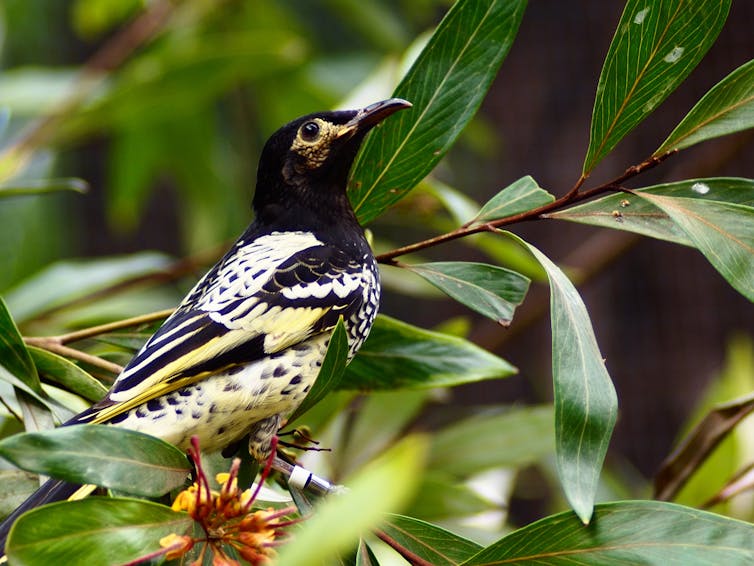
The largest protected area is Wollemi National Park (499,879 ha) in the north. This park is, famously, home to the last wild population of Wollemi Pine. These trees have a deeply ancient lineage tracing back to when the Earth’s land masses were all part of the supercontinent Gondwana over 100 million years ago.
Read more: Wollemi pines are dinosaur trees
The World Heritage area harbours 1,500 plant species, and 127 of them are rare or threatened. And in an outstanding example of the area’s uniqueness, it also contains more than 90 Eucalypt species — 13% of the global total.
The World Heritage area is also an important habitat for many rare and threatened animal species.
One celebrated seasonal visitor is the critically endangered regent honeyeater. Also under threat, and unique to the Blue Mountains, is the leura skink, which survives only in a handful of sensitive and vulnerable wetland communities.
Current Threats
In its new report, the IUCN lists eight current threats undermining the greater Blue Mountains area. The most worrying – those considered “very high threats” in the report — are climate change and bushfires.
The severe fires of last summer inflicted long-lasting damage to many Blue Mountains species that contribute to the unique biodiversity of the area. And climate change is an emerging environmental pressure threatening the delicate ecology of the region through rising temperatures and changes to rainfall.
The IUCN also rated invasive plant and animal species, such as foxes, feral cats, horses, cattle and deer, as a high threat. Mining and quarrying, habitat alteration and several specific aspects of climate change (storms, drought, temperature extremes) were also listed.
The IUCN also named potential threats from planned operations, including future noise pollution from the new international airport in Western Sydney. Another is the impact of periodic flooding from a proposal to raise the wall of Warragamba Dam for flood mitigation purposes.
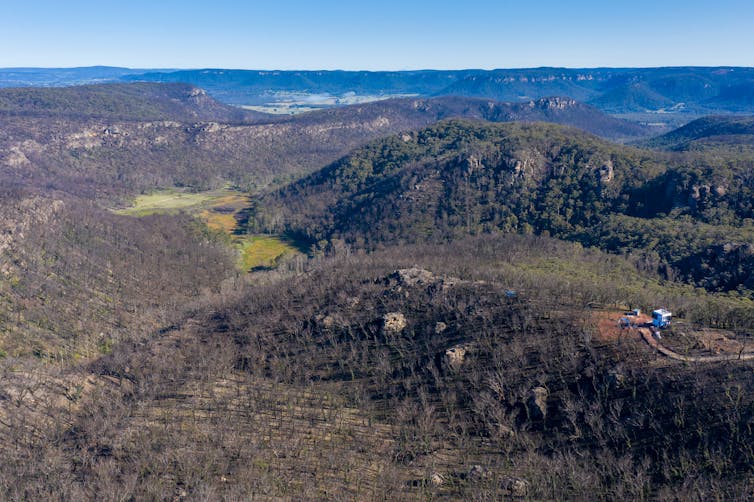
Cleaning Up Their Act
Climate change and bushfires require massive, coordinated national and international responses, but some major issues in the Blue Mountains can start to be resolved on relatively smaller scales.
For decades, the Blue Mountains have been flogged by a number of human pressures, such as an outdated sewage system from the City of the Blue Mountains and pollution from coal mining. While the environment hasn’t fully recovered, we’re pleased to see successes in the recovery efforts.
For decades, inadequate sewerage systems polluted multiple streams and rivers in the Blue Mountains.
In 1987, the Sydney Water Corporation started a 25-year, $250 million scheme to reduce water pollution from this inadequately treated sewage. And by 2010, a massive upgrade to the region’s sewage system closed 11 antiquated treatment plants.
All Blue Mountains wastewater is now treated to a higher standard at Winmalee in the lower Blue Mountains and is released away from waterways in the World Heritage area.
Another important pressure in the Greater Blue Mountains Area is from coal mining, with UNESCO expressing concerns in 2001 about water pollution from mines, such as the one operated by Clarence Colliery.
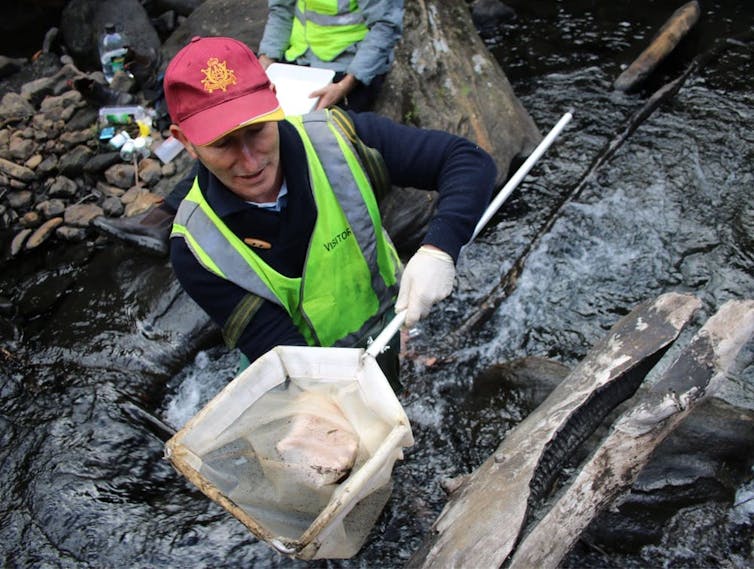
This mine is in state forest adjacent to the World Heritage area boundary. Research from 2017 found wastewater discharging from the mine was severely contaminating water quality of the Wollangambe River and damaging the ecology for more than 20 kilometres.
Read more: How our research is helping clean up coal-mining pollution in a World Heritage-listed river
Two years earlier, Clarence Colliery, owned by Centennial Coal, was prosecuted after more than 2,000 tonnes of coal material (a slurry of water and coal particles) spilled into the Wollangambe River.
Centennial Coal agreed to comply with a new EPA licence in 2017 requiring the disposal of less polluting wastes.
The latest results from October of this year are very encouraging. They show an enormous reduction (more than 95%) in the zinc concentration in mine waste, compared to 2012 levels.
Embracing ‘Planetary Health’
For an internationally important site like this, which is home to more than 80,000 residents, all levels of government must adopt the concept of “planetary health”. This recognises that human health entirely depends on the health of natural systems and embraces Indigenous knowledge.
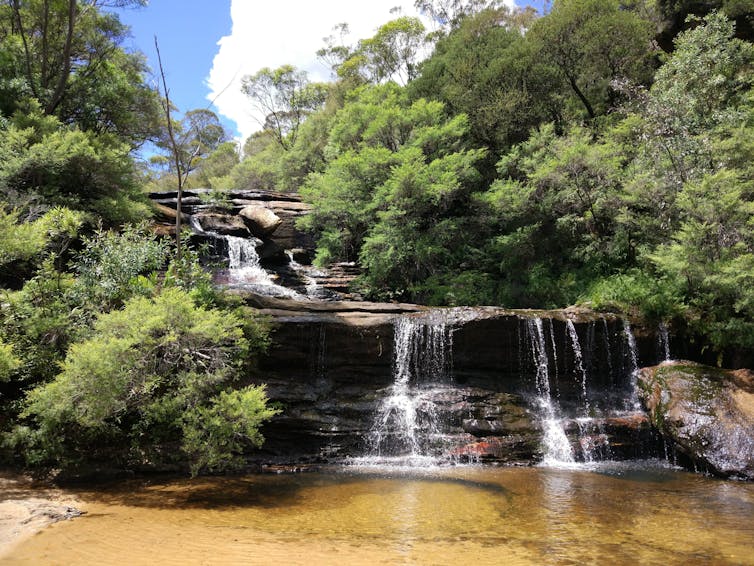
We’re pleased to see the Blue Mountains City Council is already on board. It recently announced plans to establish a planetary health leadership centre in Katoomba in partnership with universities and other educational institutions.
So while there is much to grieve, we can celebrate small successes in the Blue Mountains’ journey, which show it is indeed possible for a diverse array of parties and the broader community to work cooperatively, and start to better protect it.![]()
Ian Wright, Senior Lecturer in Environmental Science, Western Sydney University; Anthony Capon, Director, Monash Sustainable Development Institute, Monash University, and Leo Robba, Lecturer, Visual Communications / Social Design, Western Sydney University
This article is republished from The Conversation under a Creative Commons license. Read the original article.
3 reasons meeting climate targets and dumping Kyoto credits won't salvage Australia’s international reputation
Matt McDonald, The University of QueenslandToday, the Morrison government released updated projections of Australia’s greenhouse gas emissions, which indicate Australia is on track to meet 2030 Paris targets without using “carryover” credits earned from the Kyoto Protocol period.
Australia’s plan to use Kyoto carryover credits to meet Paris targets have long been contentious. The government claims that because emissions fell by more than Australia had committed to under the Kyoto Protocol, they should be allowed to carry these “credits” forward to the Paris agreement. Yet legal experts and other governments have suggested there’s no basis for applying these to the Paris agreement, which is a separate agreement.
The new modelling is good news for the Morrison government, which has been under increasing domestic and international pressure over its climate policy. And Prime Minister Scott Morrison is likely to announce this development proudly at the virtual Pacific Islands Forum on Friday night.
So are the latest projections enough to salvage Australia’s reputation on this issue? That appears unlikely.
Dumping Credits
Under the Paris Agreement, Australia committed to reducing emissions by 26-28% of 2005 levels by 2030. This target has been widely criticised for years for being too meagre, but previous modelling had suggested even meeting this target was unlikely unless carryover credits were used.
Read more: Emissions projections indicate Australia won't need carryover credits to meet Paris targets
The latest modelling suggests if the recently-announced technology roadmap — a policy which will support new and emerging clean energy technologies — is taken into account, then Australia would beat its 2030 target by 145 million tonnes. In other words, by 2030 Australia could be 29% under 2005 levels, without using carryover credits.
Morrison had flagged he would announce that Australia will dump the Kyoto credits at a global leaders’ climate summit at the weekend. However, it’s unlikely he’ll be given a speaking slot by the hosts, a reflection of his failure to make meaningful climate commitments. This is why he’ll probably make the announcement to Pacific leaders tomorrow night instead.
But even if Morrison announces he’ll scrap the controversial carryovers tomorrow, our international counterparts will still regard Australia as a climate change laggard. There are three big reasons why.
1. Our Paris Target Is Still Unambitious
A reduction of 26-28% by 2030 from 2005 levels is well below the commitments of other countries under the Paris Agreement. And under the Paris Agreement, states were encouraged to ratchet up their commitments to emissions over time.
Yet unlike other countries, Australia has not made any indication of a plan to outline a more ambitious contribution ahead of the CoP26 meeting in Glasgow next year.
It’s also worth recalling Australia’s 2005 baseline is a comparatively easy starting point. Under the Kyoto Protocol, Australia was one of only two developed countries allowed to increase its greenhouse gas emissions from 1990 levels by 2008-12.
This means most other developed countries had already reduced emissions in sectors where it was easiest for them to do so — the “low hanging fruit”. This makes further commitments under Paris more challenging for those countries than Australia.
2. Improved Projections Are No Thanks To Federal Policy
If we don’t have to use Kyoto carry-over credits to meet Paris targets, it may be despite — rather than because — of federal government policy.
Simply put, much of the decline in (projected) emissions can be attributed to the actions of state governments, which have more actively supported the renewable energy sector.

By contrast (and despite claims to the contrary) the government continues to commit billions of dollars to subsidising the fossil fuel industry. Yet there are clear indications of a declining future market for coal in particular.
Read more: Matt Canavan says Australia doesn't subsidise the fossil fuel industry, an expert says it does
While the technology investment roadmap, a federal policy, may serve to further drive down emissions, this is still far from clear.
3. There’s Still No Commitment To A Net Zero Emissions Timetable
The European Union has had a long-standing commitment to net zero emissions by 2050. More recently it has been joined by other major emitters in Japan and South Korea, while emissions giant China has committed to net zero emissions by 2060.
US President-elect Joe Biden has also committed the US to reach net zero emissions by 2050, and to return the US to the Paris agreement.
And yet, the Morrison government continues to baulk at setting a net zero emissions timetable, preferring to describe this as a general ambition rather than endorse a specific target or date.
The Response From The Pacific Will Be Telling
Australia consistently ranks among the worst performers internationally on the Climate Change Performance Index, and there are indications already that other states will actively pressure Australia on climate ambition and action in the lead up to the 2021 United Nations Climate Change Conference in Glasgow (COP26).
Combined with steadily growing domestic pressure to act on climate change and weakening financial prospects for Australia’s coal exports, international pressure may contribute to a perfect storm for the Morrison government on climate policy.
The response Morrison receives at the virtual Pacific Islands Forum to this position will be telling.
Read more: Pacific Island nations will no longer stand for Australia's inaction on climate change
The region has long been deeply critical of Australia’s climate policy, and is at the frontlines of climate change impacts such as sea level rises, natural disasters and ocean acidification.
While Morrison may avoid the same diplomatic fallout from the 2019 Pacific Islands Forum on this issue, he’s unlikely to find an audience wholly convinced Australia now recognises the scale of the threat climate change poses.![]()
Matt McDonald, Associate Professor of International Relations, The University of Queensland
This article is republished from The Conversation under a Creative Commons license. Read the original article.
Global emissions are down by an unprecedented 7% — but don’t start celebrating just yet
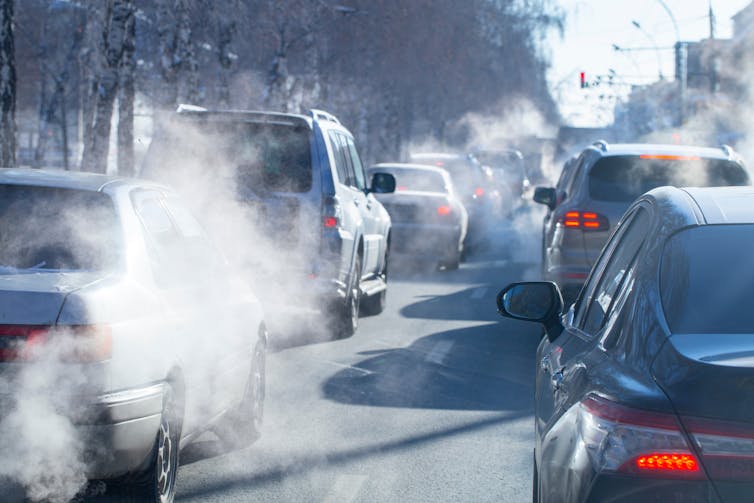
Global emissions are expected to decline by about 7% in 2020 (or 2.4 billion tonnes of carbon dioxide) compared to 2019 — an unprecedented drop due to the slowdown in economic activity associated with the COVID-19 pandemic.
To put this into perspective, the Global Financial Crisis in 2008 saw a 1.5% drop in global emissions compared to 2007. This year’s emissions decline is more than four times larger.
These are the findings we show in the 15th global carbon budget, an annual report card of the Global Carbon Project on the sources and removals of carbon dioxide, the primary driver of human caused climate change.
It may sound like welcome news, but we can’t celebrate yet. A rapid bounce back of emissions to pre-COVID levels is likely, possibly by as soon as next year. A recent study found emissions in China snapped back to above last year’s levels during late spring when economic activity began to return to normal.
These findings come ahead of the Climate Ambition Summit on Saturday, where global leaders will demonstrate their commitments to climate action five years since the Paris Agreement. This huge drop in emissions should be taken as a unique opportunity to divert the historical course of emissions growth for good.
Emissions In The Pandemic Year
The total global fossil carbon dioxide emissions for 2020 are estimated to be 34 billion tonnes of carbon dioxide.
Estimated emissions at the beginning of December are lower than their levels in December last year, at least in the transport sectors. However, emissions have been edging back up since the peak global daily decline of 17% in early April.
Read more: The world endured 2 extra heatwave days per decade since 1950 – but the worst is yet to come
The decline in emissions in 2020 was particularly steep in the United States (12%) and European Union (11%), where emissions were already declining before the pandemic, mainly from reductions in coal use.
Emissions from India dropped by 9%, while emissions from China, which have returned to close or above 2019 values, saw an estimated drop of only about 1.7%.
Australian greenhouse gas emissions during the peak of the pandemic lockdown (the quarter of March to June 2020) were lower by 6.2% compared to the previous quarter. The largest declines were seen in transport and fugitive emissions (emissions released during the extraction, processing and transport of fossil fuels).
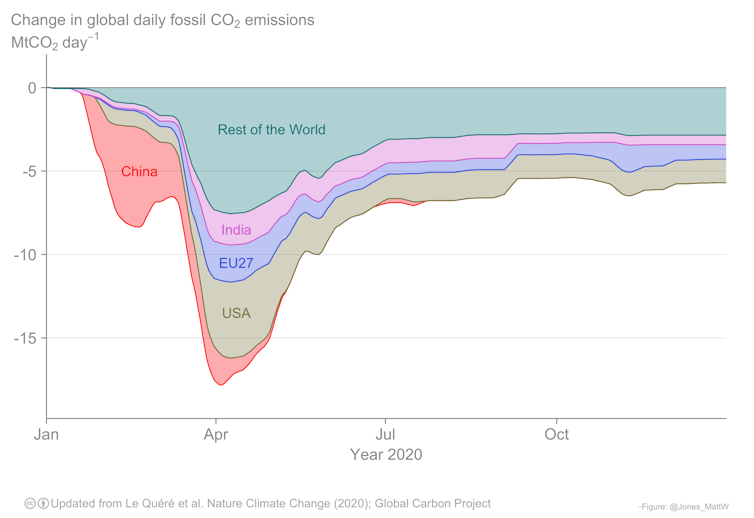
Globally, the transport sector also contributed the most to the 2020 emissions drop, particularly “surface transport” (cars, vans and trucks). At the peak of the pandemic lockdowns, the usual levels of transport emissions were halved in many countries, such as in the US and Europe.
While aviation activity collapsed by 75%, its contribution to the total decline was relatively small given the sector only accounts for about 2.8% of the total emissions on an average year. The number of global flights was still down 45% as of the first week of December.
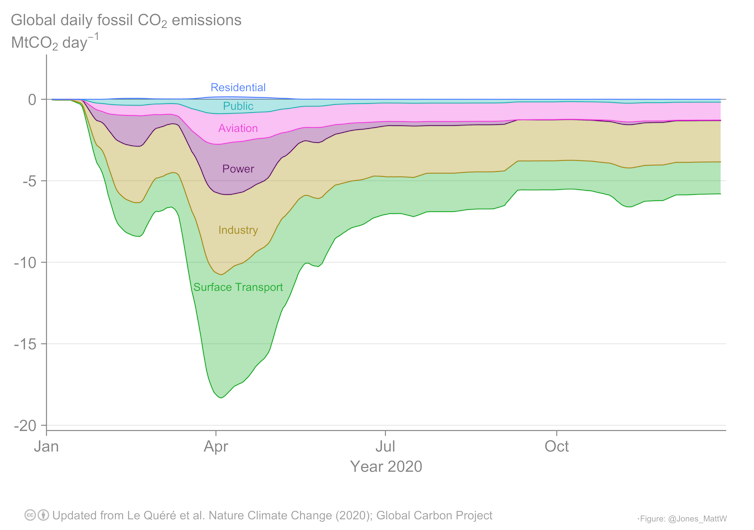
Global Emissions Were Already Slowing Down Pre-COVID
Overall, global emissions have increased by 61% since 1990. But the pace of this growth has varied.
In the early 1990s, the growth in emissions slowed down due to the collapse of the former Soviet Union, but then increased very quickly during the 2000s, by 3% per year on average. This was, in part, due to the rise of China as an economic power.
Read more: South Korea's Green New Deal shows the world what a smart economic recovery looks like
Over the last decade, however, the pace of emissions began to slow again, with an increase just below 1% per year. And emissions in 2019 didn’t grow much, if at all, when compared to 2018.
Behind the global slowing trend, there are 24 countries that had carbon dioxide fossil emissions declining for at least one decade while their economy continued to grow. They include many European countries such as the Denmark, the UK and Spain, and the USA, Mexico and Japan. For the rest of the world, emissions continued to grow until 2019.
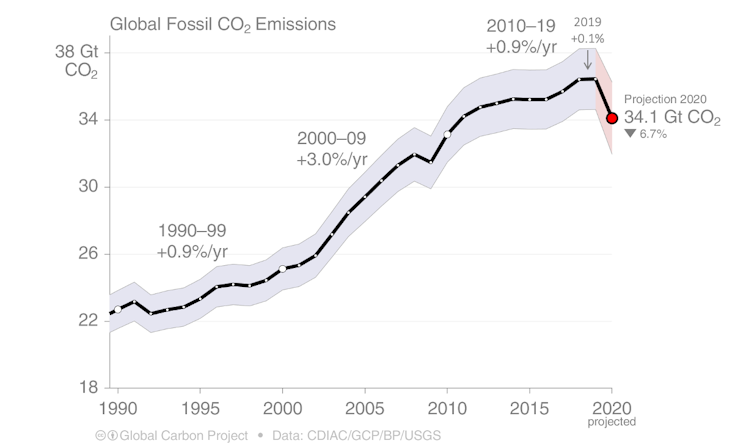
An Opportunity To Boost Ambition
The pandemic, along with other recent trends such as the shift towards clean energy, have placed us at a crossroad: the choices we make today can change the course of global emissions.
In addition to the slow down in global emissions in recent years, and this year’s drop, there are now dozens of countries that have pledged to reach net zero emissions by mid century or soon after.
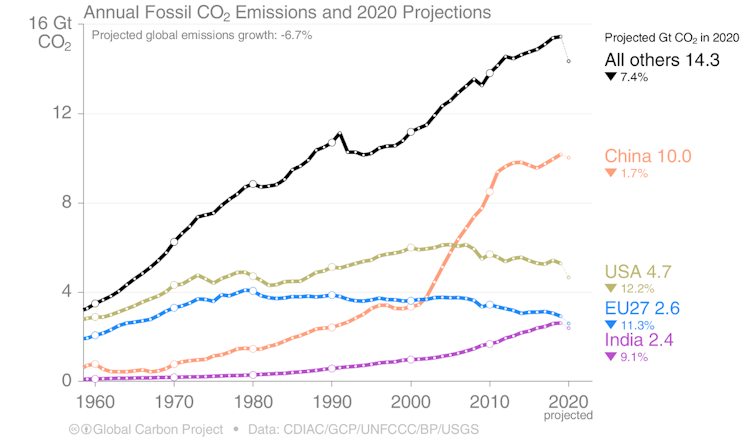
Importantly, the first (China), second (USA), third (European Union), sixth (Japan) and ninth (South Korea) top emitters — together responsible for over 60% of the global fossil carbon dioxide emissions — have either legally binding pledges or serious ambitions to reach net zero emissions by 2050 or soon after.
Coal production, the largest fossil fuel source of carbon dioxide emissions, peaked in 2013. Its decline continues to this date; however, increasing natural gas and oil negate much of this decline in emissions.
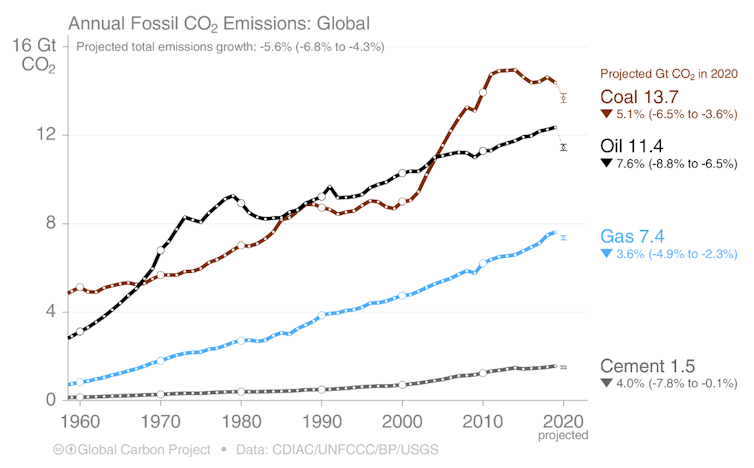
We are in the midst of extraordinary levels of economic investment in response to the pandemic. If economic investment is appropriately directed, it could enable the rapid expansion of technologies and services to put us on track towards net zero emissions.
Many countries have already committed to green recovery plans, such as South Korea and the EU, although investments continue to be dominated by the support of fossil-based infrastructure.
As global leaders prepare for tomorrow’s summit, they have an opportunity like never before. The choices we make now can have a disproportionate impact on the future trajectory of emissions, and keep temperature rise well and truly below 2℃.
Read more: Coronavirus is a 'sliding doors' moment. What we do now could change Earth's trajectory ![]()
Pep Canadell, Chief research scientist, Climate Science Centre, CSIRO Oceans and Atmosphere; and Executive Director, Global Carbon Project, CSIRO; Corinne Le Quéré, Royal Society Research Professor, University of East Anglia; Glen Peters, Research Director, Center for International Climate and Environment Research - Oslo; Matthew William Jones, Senior Research Associate, University of East Anglia; Philippe Ciais, Directeur de recherche au Laboratoire des science du climat et de l’environnement, Institut Pierre-Simon Laplace, Commissariat à l’énergie atomique et aux énergies alternatives (CEA); Pierre Friedlingstein, Chair, Mathematical Modelling of Climate, University of Exeter; Robbie Andrew, Senior Researcher, Center for International Climate and Environment Research - Oslo, and Rob Jackson, Professor, Department of Earth System Science, and Chair of the Global Carbon Project, Stanford University
This article is republished from The Conversation under a Creative Commons license. Read the original article.
Tick Population Booming In Our Area
Residents from Terrey Hills and Belrose to Narrabeen and Palm Beach report a high number of ticks are still present in the landscape. Local Veterinarians are stating there has not been the usual break from ticks so far and each day they’re still getting cases, especially in treating family dogs.
To help protect yourself and your family, you should:
- Use a chemical repellent with DEET, permethrin or picaridin.
- Wear light-colored protective clothing.
- Tuck pant legs into socks.
- Avoid tick-infested areas.
- Check yourself, your children, and your pets daily for ticks and carefully remove any ticks using a freezing agent.
- If you have a reaction, contact your GP for advice.
 Shorebird Identification Booklet
Shorebird Identification Booklet
The Migratory Shorebird Program has just released the third edition of its hugely popular Shorebird Identification Booklet. The team has thoroughly revised and updated this pocket-sized companion for all shorebird counters and interested birders, with lots of useful information on our most common shorebirds, key identification features, sighting distribution maps and short articles on some of BirdLife’s shorebird activities.
The booklet can be downloaded here in PDF file format: http://www.birdlife.org.au/documents/Shorebird_ID_Booklet_V3.pdf
Paper copies can be ordered as well, see http://www.birdlife.org.au/projects/shorebirds-2020/counter-resources for details.
Download BirdLife Australia's children’s education kit to help them learn more about our wading birdlife
Shorebirds are a group of wading birds that can be found feeding on swamps, tidal mudflats, estuaries, beaches and open country. For many people, shorebirds are just those brown birds feeding a long way out on the mud but they are actually a remarkably diverse collection of birds including stilts, sandpipers, snipe, curlews, godwits, plovers and oystercatchers. Each species is superbly adapted to suit its preferred habitat. The Red-necked Stint is as small as a sparrow, with relatively short legs and bill that it pecks food from the surface of the mud with, whereas the Eastern Curlew is over two feet long with a exceptionally long legs and a massively curved beak that it thrusts deep down into the mud to pull out crabs, worms and other creatures hidden below the surface.
Some shorebirds are fairly drab in plumage, especially when they are visiting Australia in their non-breeding season, but when they migrate to their Arctic nesting grounds, they develop a vibrant flush of bright colours to attract a mate. We have 37 types of shorebirds that annually migrate to Australia on some of the most lengthy and arduous journeys in the animal kingdom, but there are also 18 shorebirds that call Australia home all year round.
What all our shorebirds have in common—be they large or small, seasoned traveller or homebody, brightly coloured or in muted tones—is that each species needs adequate safe areas where they can successfully feed and breed.
The National Shorebird Monitoring Program is managed and supported by BirdLife Australia.
This project is supported by Glenelg Hopkins Catchment Management Authority and Hunter Local Land Services through funding from the Australian Government’s National Landcare Program. Funding from Helen Macpherson Smith Trust and Port Phillip Bay Fund is acknowledged.
The National Shorebird Monitoring Program is made possible with the help of over 1,600 volunteers working in coastal and inland habitats all over Australia.
The National Shorebird Monitoring program (started as the Shorebirds 2020 project initiated to re-invigorate monitoring around Australia) is raising awareness of how incredible shorebirds are, and actively engaging the community to participate in gathering information needed to conserve shorebirds.
In the short term, the destruction of tidal ecosystems will need to be stopped, and our program is designed to strengthen the case for protecting these important habitats.
In the long term, there will be a need to mitigate against the likely effects of climate change on a species that travels across the entire range of latitudes where impacts are likely.
The identification and protection of critical areas for shorebirds will need to continue in order to guard against the potential threats associated with habitats in close proximity to nearly half the human population.
Here in Australia, the place where these birds grow up and spend most of their lives, continued monitoring is necessary to inform the best management practice to maintain shorebird populations.
BirdLife Australia believe that we can help secure a brighter future for these remarkable birds by educating stakeholders, gathering information on how and why shorebird populations are changing, and working to grow the community of people who care about shorebirds.
To find out more visit: http://www.birdlife.org.au/projects/shorebirds-2020/shorebirds-2020-program
Pittwater Reserves
Aussie Bread Tags Collection Points

Life, The Universe And Everything: Some Of UNSW's Most-Read Science Stories Of 2020
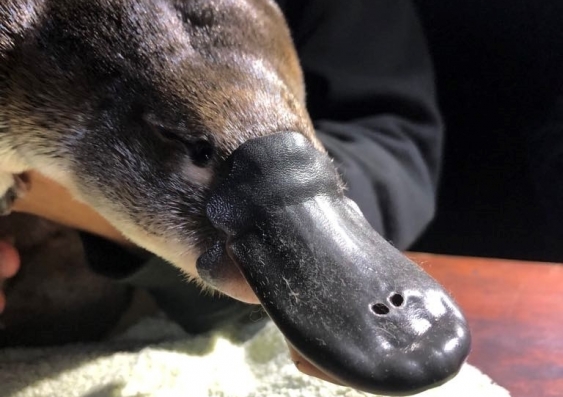
Australian Pilot Whale Study Reveals Copycat Calls To Outsmart Predators
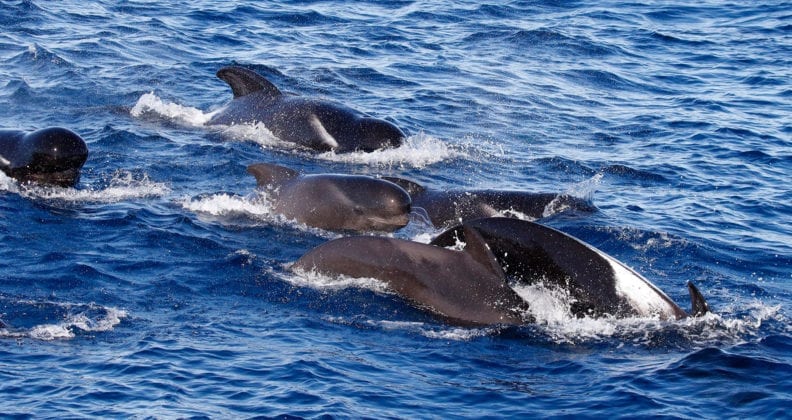
BHI Results Show Elective Surgery Blitz In NSW Hospitals
Santa was a lady once — is it time to bring her back?
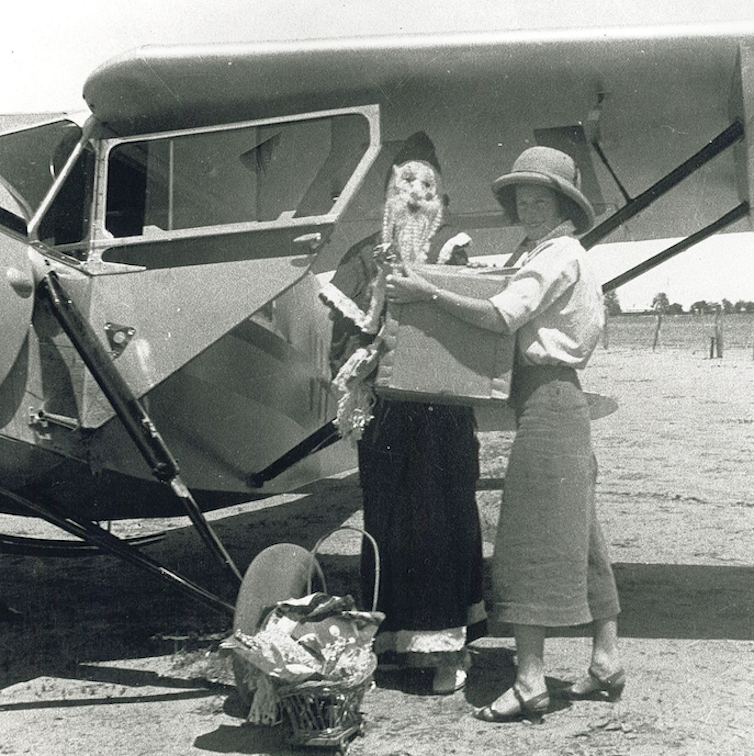
Can Christmas be about gender? Apparently so, if the paucity of female Santas is anything to go by. There have, in fact, been cases of Australian women donning the secular red and white Santa attire as far back as 1930 — and there is no reason why we couldn’t have more female Santas today.
In 1935, Queensland’s Daily Mercury reported on aviator Nancy Bird Walton, “The Angel of the Outback”, piloting a female Santa Claus into the north-western corner of New South Wales.

Bird was a volunteer with the Far West Children’s Health Scheme, flying nurses to remote parts of Australia, and transporting patients. “A girl was the first Father Christmas for the isolated area,” the article noted.
Before Bird, in 1930, the Daily Pictorial had published a photo titled: “Sydney’s Woman Santa”. The caption described, “Mrs Thelma Lewis, of Randwick, believed to be Australia’s only woman Santa Claus”, filling a role she adored.
These cases from 1930s Australia provide a glimpse of women breaking the rules of socially accepted female behaviour. (Bird was temporarily suspended from flying in 1935 when a state politician pronounced ladies were not “biologically suited” to the activity).
Read more: We asked five experts: should I lie to my children about Santa?
A ‘Slimmer, Smaller’ Wartime Santa
During the second world war, as with the first, women assumed male roles out of necessity. This included donning a Santa suit. In 1942, Perth’s Daily News reported: “Female Santa Claus this Year”. The article read:
There will be a subtle change in the person of Santa Claus this year. He will probably be slimmer and smaller, and he probably won’t talk, because his voice won’t be quite as deep as it should be. Mother will have the difficult job of deputising for Santa Claus this year, as most fathers in camp and on ships will not get leave.
Women stepped in during wartime in the United States too, although the response was not as pretty. A 1941 article in the St. Louis Star-Times, insisted
There is one male domain, however, that should be defended at all costs … A woman Santa Claus? Heaven forbid! That would be stretching the credulity of guileless little children too far.
Despite the grumbling, American women continued to play Santa during the war years, often with little protest.
‘Mother Christmas’

In Australia, the practice also continued after the war. On December 10 1949, Brisbane’s Courier-Mail reported on a “Mother Christmas” who visited children at a childcare centre.
The story was titled, “Santa Was A Lady”. The caption for the photograph read, “Woman invaded man’s realm yesterday when a Mother Christmas (Mrs. E. J. Lewis) operated at Kurilpa Child Care Centre. She got the same glad welcome that Father Christmas gets.”
In 1950, meanwhile, a “Glamorous Girl ‘Santa’” cycled into the Christmas party at Freidelle’s, a Wollongong-based manufacturer of children’s clothes. The reporter described her arrival thus:
Furiously riding a bicycle, and with scant consideration to traffic regulations, the ‘Girl Santa’ arrived on the scene at Freidelle’s Xmas Breaking-up party on Thursday and challengingly announced ‘Well, here I am!’
Freidelle’s employed women and was one of the main industries in the region to provide jobs for migrants. In such a context, its female Santa seems to have made sense.
Read more: Teleporting and psychedelic mushrooms: a history of St Nicholas, Santa and his helpers
Resistance
In the final decades of the 20th century, there was more resistance to female Santas. In Australia, Santa became a bloke again. In the US, the few women Santas working in department stores were either sacked or encouraged to seek alternative employment.
In 1999, a female Santa sued a Walmart in Louisville for unfair dismissal after a customer complained it was a man’s job. She lost.
But the tide may be turning as we settle into the new millennium. In 2018, in Gisborne, New Zealand, Santa was a “female, regional, Maori, queer”. Also in 2018, in Park City Mall in Lancaster, Pennsylvania, “Tranta Claus” (a transgender Santa) came to town.
The future of our beloved Santa — the guy in the red suit originating from the story of St Nicholas in fifth century Turkey — may be increasingly contested. And with older, overweight men said to be at a higher risk of catching coronavirus, now is the time to rethink the notion of who can play Santa.
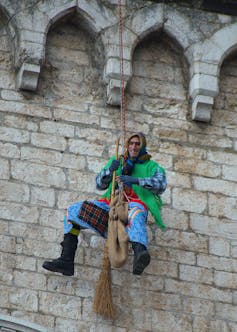
Gender switches at Christmas are really nothing new. In Italy, the Christmas tradition of a magical being bearing gifts has been part of culture for hundreds of years in the form of a folkloric witch called The Befana.
First recorded in a poem in 1549, the Befana is old, rides a broomstick, carries a sack full of treats (and coal), and wears a black shawl and either a headscarf or tall hat. Like Santa, she enters homes via chimneys, filling the socks or stockings of children with gifts
Male cross-dressing is part of an age old tradition of pantomime throughout Europe, prevalent around Christmas. So in Italy, the Befana is often performed by men donning female attire.![]()
Marguerite Johnson, Professor of Classics, University of Newcastle
This article is republished from The Conversation under a Creative Commons license. Read the original article.
How the Australian Women's Weekly spoke to '50s housewives about the Cold War

Under editor Esmé Fenston, by the end of the 1950s, the Australian Women’s Weekly was selling over 805,000 copies a week. More than half of all Australian women read the magazine.
It focused on promoting a vision of the “everyday” Australian woman. Of course she did not represent all women — she was white, middle class, not working in paid employment and devoted to her home and family. Articles on fashion, cooking, homemaking, motherhood and romance supported this image.
But the Weekly also saw itself as a “women’s paper” with a responsibility to educate its readership by including current affairs and news stories in each issue.
While we might not think of the 1950s housewife as taking an active interest in Cold War politics, a close reading of the Weekly – the “popular face of femininity” – shows Australian women were not only interested in global politics, but encouraged to join in the discussion.
The 1950s Political Landscape
The second world war had changed Australian society, particularly for women. As men were sent overseas, women filled the jobs men left behind. US servicemen charmed local women — who explored the new sexual and romantic opportunities available to them.
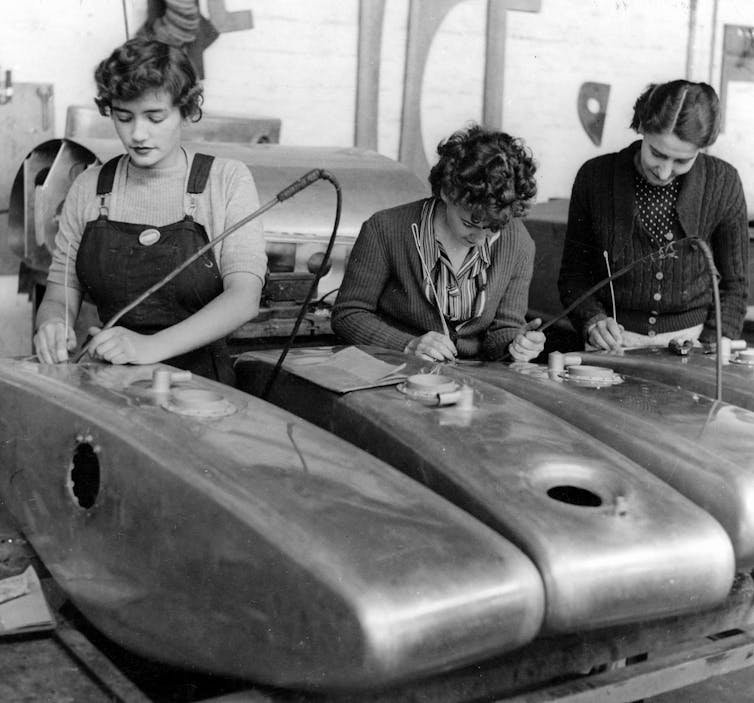
Though encouraged by the government to return to their homemaking duties, after the war, many women continued to work in paid employment and were more vocally interested in romance and sex.
By the early 1950s, meanwhile, the Cold War dominated international politics as the world split into two political blocs, aligned with the communist Soviet Union or the capitalist United States. Australia allied with the US, and fear of communism spread, with suspicion of anyone not following social norms.
Many Australians, particularly the middle classes, feared women would abandon their traditional family-focused roles. The family home thus became a symbol of peace and security and a bulwark against communist overthrow.
Female Readers As Thinkers
The Weekly was clear in the belief women should be engaged with Cold War politics. In 1955, after the first Taiwan Strait Crisis, Fenston rued “not one woman is directly concerned with the deliberations that may or may not lead to war”.
She encouraged her readers to take on a bigger role in these discussions, paraphrasing Alfred Tennyson’s poem Locksley Hall to profess her hope that in the future “women’s commonsense shall hold a fretful realm in awe” as they took an active part in diplomacy and politics.
On the topic of nuclear weapons, an article by the Canadian physician Dr Marion Hilliard in 1958 urged women to:
rise up and say: It’s time to stop. Let there be no more use of weapons which will let loose radioactive power in this world. My child, all the children of the world should have a chance to start life as sound in body and mind as possible.
Over the decade, Cold War topics were regularly combined with more socially acceptable feminine issues. In 1953, an article by Sylvia Connick appeared on the surface to be a simple romantic story of an Australian girl and a her Czechoslovakian fiancé.
But within this, Connick referenced the oppression of Soviet rule in Czechoslovakia and the horrors of communist labour camps.

The magazine positioned women as a distinct category of political thinker who had “instinctive” knowledge of how to conduct herself in political discussions with her contemporaries.
As Fenston wrote in an editorial on the 1954 Big Four Conference between France, America, Britain and the Soviet Union, while “the finer points of high-level diplomacy may be lost to many women”, women knew “tongues before guns” was a more effective political tool.
Using domestic analogies of “a quiet talk over the back fence” to describe international relations, Fenston suggested that women instinctively understood how diplomacy was more effective than the nuclear war tactics of “hurling rocks on your neighbour’s roof.”
Feminised Politics
Reading the magazine’s Cold War articles, it would be easy to conclude the Weekly believed women were uninterested in international politics unless a feature also included comments on the latest fashion.
This would be a disservice to the magazine and its readership.
Instead, this approach is an example of what I have termed “feminised politics”. Overt political discussions were combined with conventionally acceptable feminine themes to avoid provoking widespread anxieties about social changes.
This feminised politics echoed the maternal feminism of the early 20th century, used by suffragists to argue women would bring a maternal morality to the political sphere, updated to fit with the changed social context.

Women’s political interests in the 1950s are often forgotten, sandwiched as the period is between the very public first and second wave feminist movements. But while the 1950s housewife did indeed spend a lot of time on homemaking duties, that did not mean she sat out the important political discussions shaping her world.![]()
Hannah Viney, PhD Candidate, School of Philosophical, Historical & International Studies, Monash University
This article is republished from The Conversation under a Creative Commons license. Read the original article.
Caring for 66,455 revellers at risk delivers $7.5m harm-reduction benefit for Sydney
Phillip Wadds, UNSW; Anthony Shakeshaft, UNSW, and Christopher Doran, University of NewcastleOur time of social isolation under COVID-19 restrictions has reinforced the importance of taking care of each other, particularly the most vulnerable in our community. As we consider what our post-COVID social world will look like, we have an opportunity to deliver services that make our cities safer and more inclusive. An example of how we might achieve this can be found in a Sydney harm-reduction service that has assisted tens of thousands of nightlife revellers who are vulnerable, in distress or at risk of harm since 2014.
A newly released evaluation conservatively estimates the benefits of the Take Kare Safe Space (TKSS) program from December 2014 to April 2019 at A$7.46 million. That benefit includes the value of serious harm averted and the value attached to lives saved through program interventions.
While it may have been less prominent in our public and political consciousness this year, nightlife, and the way we socialise after dark, is a major part of our social and cultural life. It will return.
In Sydney, where trading restrictions – the so-called lockout laws – were lifted in January following five years of controversy, we need to do nightlife better. We need to find the balance between safety and vibrancy. The city is a great place to go out, but also a place where we need to provide the right services for when things inevitably go wrong.
Read more: Where are they now? What public transport data reveal about lockout laws and nightlife patronage
One Part Of The Solution
The TKSS program has been doing this throughout the lockout period in Sydney. Now operated by Stay Kind, the TKSS program was launched in 2014 following the unprovoked attack and subsequent death of Thomas Kelly in Kings Cross in 2012.
Operating year-round from 10pm to 4am on Friday and Saturday nights, it’s a non-judgmental, non-government, harm-reduction service. The program looks after nightlife revellers who are vulnerable, in distress or at risk of harm.
Teams of Take Kare ambassadors work in co-operation with the City of Sydney’s CCTV control room and other nightlife services to patrol key precincts, acting as critical intermediaries between emergency services.
During the evaluation, TKSS operated three static safe spaces at Town Hall, Kings Cross and Darling Harbour. Here, nightlife revellers can go to chill out, get help, charge their phones, or receive basic first aid.
Between December 2014 and April 2019, TKSS supported 66,455 people. Two-thirds of them were aged 18-25. Many (46%) were perceived as heavily intoxicated and at risk of harm.
What Is The Evidence? Does It Work?
Researchers from UNSW Sydney and Central Queensland University recently completed a comprehensive independent evaluation of the TKSS program. Funded by the NSW Department of Communities and Justice, the evaluation team analysed crime, emergency department and ambulance data to establish the benefit-cost ratio of the program. We also interviewed key stakeholders and “clients” about their perceptions of the program.
From December 2014 to April 2019 (inclusive), the benefits were estimated at $7.46 million. With operating costs of $2.79 million, the benefit-cost ratio was 2.67:1. In other words, a $1 investment in the program resulted in $2.67 of benefits. When the TKSS program was fully operational in all three safe space sites (in 2016-17), the benefit-cost ratio increased to 3.83:1.
These results are conservative. The return on investment is likely to be much higher given the analysis does not quantify the full spectrum of benefits associated with the program. These include: improved public safety and amenity; more efficient resource allocation for service providers; improved partnership, communication and resourcing to manage Sydney nightlife; and flow-on effects for tourism and investment.
Read more: 'Sanitised' nightlife precincts become places where some are not welcome
What Are The Strengths Of TKSS?
These non-quantifiable benefits featured strongly in interviews with stakeholders. They included staff from NSW Police and Ambulance, St Vincent’s Emergency Department, City of Sydney, licensed venues and those who used the service. They highlighted a number of key program strengths, including:
1. the program fills a critical gap in nightlife safety – TKSS staff act as intermediaries between licensed premises and emergency services by providing services in public city spaces where people are most vulnerable – and it’s also easy to deploy in different locations as needed
2. the non-judgmental, non-authoritative nature of the program meant intoxicated, vulnerable and distressed nightlife patrons were more comfortable speaking with TKSS ambassadors than other services – such as police, ambulance, venue security or city rangers – and this rapport helped encourage at-risk patrons to willingly get medical help when needed
Read more: Fewer alcohol-related visits to inner Sydney emergency room since 'lockout laws' introduced
3. police, ambulance and accident and emergency staff said the TKSS program allowed them to focus on more urgent and pressing jobs
4. the ambassadors are able to de-escalate conflict and provide welfare services through their early, proactive and non-judgmental interventions.
The evaluation shows the TKSS program provides a critical harm-reduction service in Sydney after dark. Its net economic benefit to the city is greatest when the full complement of Safe Spaces are operating and supported by sustained and stable funding. There is a clear case that the program should be part of the long-term future planning of a safe, inclusive and vibrant night-time economy.
Note: The TKSS program was suspended in March 2020 due to COVID-19 and is due to re-open in January 2021.![]()
Phillip Wadds, Senior Lecturer in Criminology, UNSW; Anthony Shakeshaft, Professor and Deputy Director at National Drug and Alcohol Research Centre, UNSW, and Christopher Doran, Professor of Health Research Economics, University of Newcastle
This article is republished from The Conversation under a Creative Commons license. Read the original article.
Feel free to disagree on campus ... by learning to do it well

The French Review didn’t confirm a “free speech crisis” in Australian universities. But nor did its report last year confirm free speech was “alive and well”, as Universities Australia would have it. In many university policies the report found vague language, which could rule out voicing a view deemed offensive.
Most universities have updated their policies in response to the French Review’s Model Code on Freedom of Speech and Academic Freedom, and related amendments to higher education legislation are before the parliament. On Wednesday, the Walker Review of universities’ implementation of the code reported that many don’t fully reflect the code yet.
However they fare on this, many will also recall the French Review’s observation:
A culture powerfully predisposed to the exercise of freedom of speech and academic freedom is ultimately a more effective protection than the most tightly drawn rule. A culture not so predisposed will undermine the most emphatic statement of principles.
Of course, universities promote respect for others’ rights, and civility more generally. They have a duty to foster the well-being of students and staff. But in the model code this doesn’t “extend to a duty to protect any person from feeling offended or shocked or insulted by the lawful speech of another”.
Like the Chicago Principles, the model code reflects legal limits on free expression, but doesn’t seek to enforce civility as a formal campus rule. It recognises universities as institutions where disagreement runs deep and where diverse views — even those some find offensive — should be exchanged freely and challenged openly.
Read more: Four fundamental principles for upholding freedom of speech on campus
So, apart from clarifying policy, how can universities promote a “free to disagree” culture on campus? Not just in name, but in norms?
Learning How To Disagree Well
One way may be to focus more on teaching students how to argue persuasively. On topics where positions are polarised, ad hominem attacks are common. On the topic of climate change, for example, debates often slide into shouting matches between “deniers” and “zealots”. Or they may proceed mainly in the form of petty point-scoring, as in the recent US presidential debates.
Read more: The first US presidential debate was pure chaos. Here's what our experts thought
To keep debates robust and constructive, it helps to recognise other diversionary tactics and defensive routines. My “Disagree Well On Campus” model (shown below — click to enlarge) calls on scholars to aim high.
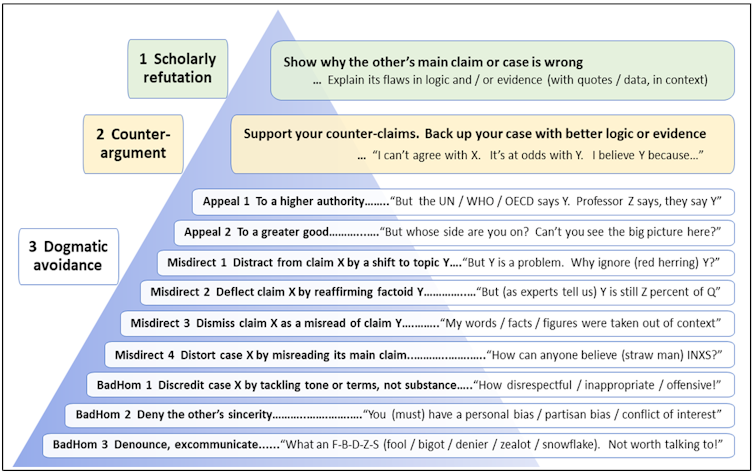
This means they should contest an opponent’s claims with logic and evidence, a level 2 counter argument. If they can do this well enough, the case at hand — whether mainstream or minority — may be refuted (or reframed, or reaffirmed) to a scholarly standard, level 1.
But, as the list of level 3 “dogmatic avoidance” tactics suggests, there are many ways to differ without resolving anything. At the low end, personal accusations and name-calling aren’t arguments in a level 2 sense. Often they signal a refusal to debate the substance of this kind of topic with that kind of person.
Consider how your last big argument went. Was it level 1, 2 or 3?
Level 3 Tactics Explained
At level 3, the first two “appeal” tactics enlist support for a view by appealing to a higher authority or greater good. (But how far do we rely on one, or prioritise the other?)
The next four “misdirection” tactics evade the point of an opponent’s view. This is done mainly by raising other concerns. (But how relevant and significant are these to the main argument?)
The final three “exclusion” tactics withdraw the commitment to engage with an opponent’s viewpoint, or take it seriously, by casting doubt on their morality, sincerity or credibility.
At level 3, common avoidance tactics include “straw man” arguments (Misdirect 4). An opponent’s view is restated in a way that gives it unintended meanings. This caricature is then refuted, instead of the actual claim.
Another tactic is to cite a technical fact as a trump card, which seems to settle which side is right (Misdirect 2). But this may be a “red herring” that leads away from the point at issue (Misdirect 1). Or it may be an unreliable form of evidence. The phrase “lies, damned lies and statistics” refers to the use of carefully selected factoids to prop up or put down a case. Often this amounts to spin by omission, not the level of proof that independent experts would accept.
Another level 3 tactic is to take offence at the tone or terms of an opposing view, without addressing its substance (BadHom 1). This is more civil than calling someone an FBDZS — a fool, bigot, denier, zealot or snowflake (BadHom 3). But by shifting off-topic to invoke rules of civility, it offers scope to censor or end the exchange without conceding any substantive point.
Read more: There are differences between free speech, hate speech and academic freedom – and they matter
‘Heretic Protection’ On Campus – But With Rigour
Many debates mix level 2 and level 3 ways of arguing. Some are “won on the day” with level 3 tactics alone. But rhetorical point-scoring doesn’t amount to scholarly refutation.
Once a majority view seems settled on this basis, any dissenting minority view — even one with valid points to make — may become undiscussable. In a university context, this is where the principle of academic freedom does its work. As one scholar observes: “popular or mainstream ideas generally need no protection”.
As places of higher learning, universities assume responsibility for protecting free expression and open exchange when views diverge, while also promoting the practice of scholarly refutation. This stance affords “heretic protection” to minority views, while also exposing them to robust counter-argument.
As future leaders and experts, university graduates will need to reach and justify decisions that have wide real-world consequences. Often these decisions will be made in the face of firm opposition from many of those affected. Being able to argue clearly and persuasively, and to tell the difference between a well-reasoned case and slippery rhetoric, will be critical professional skills.![]()
Geoff Sharrock, Honorary Senior Fellow, Centre for Vocational and Educational Policy, University of Melbourne
This article is republished from The Conversation under a Creative Commons license. Read the original article.
Predictions For 2021; The Age Of Aquarius Dawns, Blues Will Win State Of Origin 3-0, Baby Boomers Are Taking To Social Media Platforms +++
Satellite Tracking Finds Turtle Foraging Areas In Australia's North-West
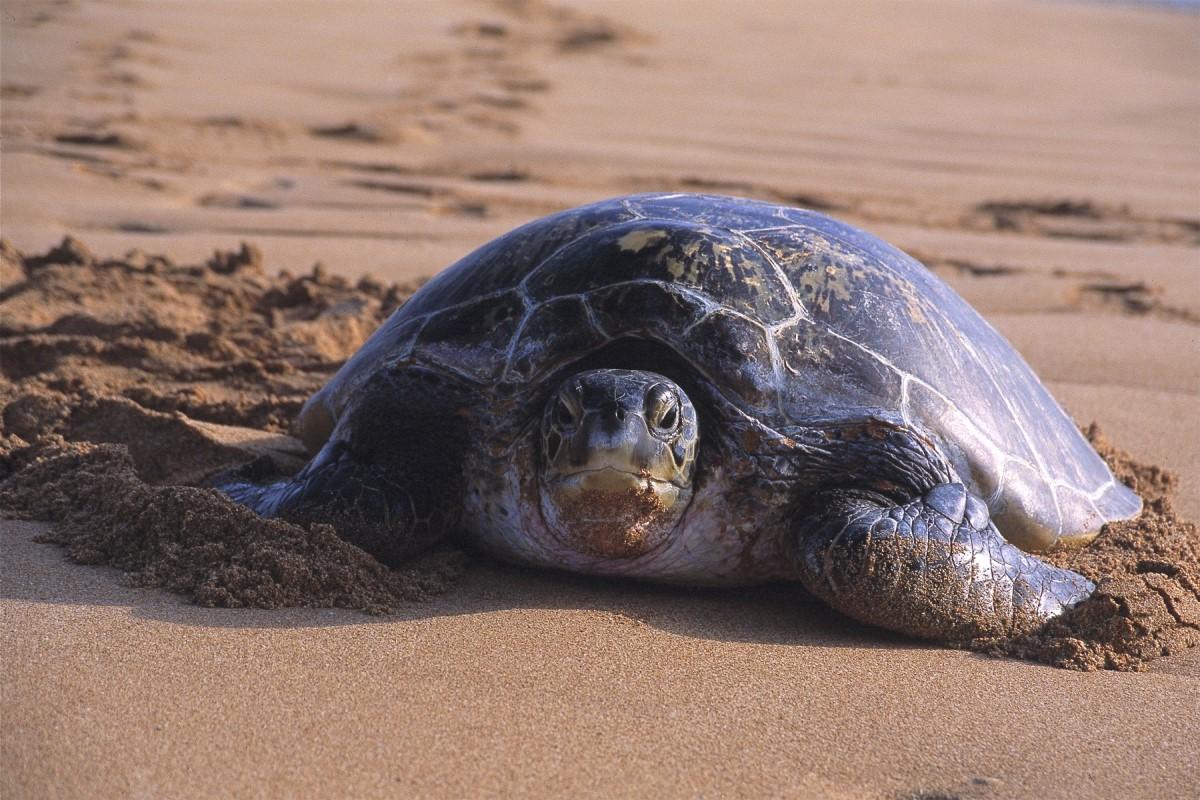
Sydney Poised To Be A Global Hub For Quantum Technology
Disclaimer: These articles are not intended to provide medical advice, diagnosis or treatment. Views expressed here do not necessarily reflect those of Pittwater Online News or its staff.